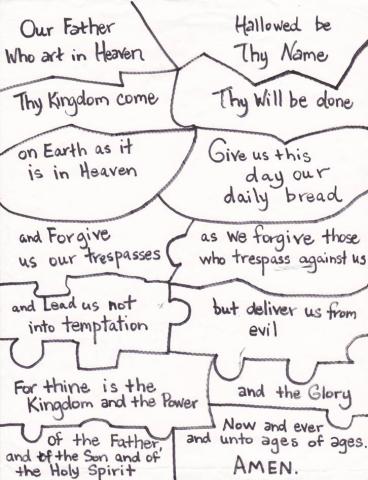Ages 6 - 8 The Gospels - Overview (Schedule, Recipes, etc..)
CHURCH SCHOOL
THE LIFE OF JESUS – THE GOSPELS
AGES 6-7
This file is provided as a resource for Church School directors. Feel free to plug in your own dates and your own teachers.
TEACHERS:
|
Date |
Lesson/Activity |
Teacher |
Special Notes |
|
September 12
18 19
26
|
Nativity of Theotokos/ Presentation of Theotokos
Movie Night Annunciation
Birth of John the Baptist
|
|
Outdoor, Parish-wide |
|
October 3
10
17
23 24
31
|
Nativity of Our Lord
Meeting of Our Lord
The Three Kings
Movie Night Flight to Egypt
Nazareth and the Temple/ All Saints Party
|
|
Memory Work: St. Simeon’s Prayer
Operation Christmas Child due Dress as favorite gospel character |
|
November 7
14
20 21
28
|
Theophany
Temptations of Jesus
Movie Night Wedding at Cana
Calling of the Fishermen
|
|
Memory : Troparion Jar Decorating
Jewish Dancing
Memory Work: 12 Disciples |
|
December 4 5
12
19
26 |
St. Nicholas Festival Calling of Matthew
Woman at the Well
Christmas Pageant
Sermon on the Mount |
|
10 AM-1 PM in hall
Memory Work: Beatitudes |
|
January 2
9
15 16
23
30
|
Walking on Water/Calming of Storm
Feeding of 5000
Movie Night Transfiguration
The Good Samaritan
Parable of the Sower |
|
Canned Goods 3 Kings Party
Health Kits |
|
February 6
13
17
27 |
Zaccheus
Publican/Pharisee
Prodigal Son
Last Judgment |
|
Homeless Bags
|
|
March 5 6
13
20
27
|
Movie Night Forgiveness/Paralytic
Miracles/Healing
Lazarus
Palm Sunday
|
|
Antiochian Art Contest
|
|
April 2 3
10
17
24 25
30 |
Marathon Movie Night Last Supper
Crucifixion
Resurrection
PASCHA: No Church School Easter Egg Hunt
Rehearsal for Passion Plan/Musical |
|
Memory Work: “Christ is Risen” in 3 languages
|
|
May 1
8
13-15
22
29 |
Passion Play/Musical
Doubting Thomas
Camping Trip Ages 6-12
Myrrh-bearing Women
Road to Emmaeus
|
|
For Parish/Public???
Piggy Banks Due |
|
June 5
12
19 |
Ascension
Pentecost
Lord’s Prayer |
|
Memory Work: Lord’s Prayer Awards Ceremony |
GENERAL NOTES
Classroom supplies: Each class is supplied with the following items:
Paper plates, small and large Scissors Stapler/Staples
Paper, plain and construction Tape and dispenser Paper bags
Glue or glue sticks Crayons and/or markers Cotton Balls
Popsicle sticks Chenille (colored pipe cleaners) Sharpies
If you use the last of something, please either replace it or let me know so I can replace it. If you need special craft supplies for your lesson, submit the receipt to me for reimbursement.
Books are available for class use. While each child in the younger classes will have a copy of the Beginner’s Bible, and it’s always fun to start out in your very own Bible book, many times we must supplement with the teacher’s copies of the Children’s Bible Reader, Read with Me Bible, Golden Children’s Bible, or other books. Watch the lesson plan for page numbers and details. Each has strengths and weaknesses: Children’s Bible Reader is Orthodox but no longer in print, First Bible has great pictures but not much content, Golden Bible has the most content and lovely pictures but way too long, etc. And not a one has ALL of the stories we need.
Teaching Schedule: We all know that there will be last-minute needs; trade with someone if you cannot teach on your assigned day and let the director know!
Insurance: Each of us must “apply” each year for our volunteer position of teacher. Please be sure not to send small children to the bathroom unattended and accompany your charges back to the Social Hall after class.
Opening Exercises: The Church School director will supervise this time, or delegate it when she is absent. Church School children and teachers are dismissed first from Liturgy; children come straight across for snack during opening exercises. These are an integral part of the curriculum – reviewing material from previous weeks, presenting additional Old Testament characters, rehearsing plays, hearing memory work, and playing quiz games.
Curriculum: To order the lessons, there are several that are tied to specific dates -- Zaccheus on Zaccheus Sunday, etc. Rearrange as needed and then use the parable lessons and Lord's Prayer lesson on the weeks in between, depending on the date of Pascha each year. We also have a timeline figure for each Gospel event. Use the figures provided for the story, print on cardstock (one for the whole class or use it every week for your craft), decorate (color, glitter glue, wiggle eyes, yarn hair, etc.) and hang in order from a clothesline stretched along the room with clothespins or paper clips. Easy way to review past lessons and bring in the new. With each lesson, I have included True/False questions. These help to reinforce the lesson. Feel free to expand the list. There are also a craft ideas and discussion questions. The lesson plan is one that will work, but feel free to be creative. If you have a good idea for another way to approach the lesson, another craft, etc., go right ahead. Share your idea in writing for inclusion in the next version of the curriculum!
Hand Outs: Feel free to use the coloring pages in the Parents' Guide for each lesson as take homes to supplement and reinforce the stories of the week.
Movie Nights and Parties: We will have supper after vespers on Saturday night while showing a small children’s movie. Older children should bring a sleeping bag for a lock-in with “feature” presentation only for the marathon movie night. We have several of our usual parties planned: All Saint’s, 3 Kings, Easter Egg Hunt, and, this year, the St. Nicholas Festival. All are invited; please bring friends for an outreach opportunity.
RECIPES
CLAYS PAINTS
SALT DOUGH FINGER PAINT (4 WAYS)
2 cups flour Use pudding with food coloring!
1 cup salt Mix liquid starch and food coloring.
about 1 cup water Mix 3 T sugar, ½ cup cornstarch, and
food coloring 2 cups cold water. Cook over
bath oil, vegetable oil, peppermint oil low heat, stirring, till thick.
Mix flour and salt. Add water Pour into muffin tin. Add
slowly and mix with your fingers until food coloring to each cup.
it makes dough. Knead in a few drops
food coloring and a splotch of oil (if SAND PAINT
desired). Store in air-tight container. Add dry tempera paint to corn meal.
Sprinkle over areas “painted” with white glue
SELF-HARDENING CLAY
1 cup sand for a sand effect. Shake off excess.
½ cup cornstarch
1 tsp powdered alum PASTES
¾ cup hot water PRIMARY PASTE
Food coloring if desired Mix ½ cup water and 1 cup flour
Mix sand, cornstarch and alum in a bowl. Spoon into a jar
in large pot. Add hot water and stir or squeeze bottle to store.
vigorously. Add food coloring if
desired. Cook over medium heat PAPIER MACHE PASTE
until thick, stirring constantly. 3 cups water
After cooling, store in airtight container. 1 ½ cups flour
Mix flour with cold water until lumps are gone.
SAWDUST CLAY
2 cups fine sawdust Dip strips of newsprint in paste and mold around
1 cup flour surface to be shaped. Air dry.
Mix sawdust and flour in bowl
or bucket. Add a little water at a time,
stirring till it is stiff but pliable. Knead
till it’s elastic and easy to shape. Store
in airtight container. Air dry.
CORNSTARCH DOUGH
2 cups cornstarch
4 cups baking soda
2 ½ cups water
Mix cornstarch and soda in large
pot. Add water. Cook, stirring, over medium
heat until thick like mashed potatoes. After
cool, knead on wax paper for 5 minutes. Store
in an airtight container. Air dry.
Nativity of Theotokos and Presentation of Theotokos
NATIVITY OF THE THEOTOKOS AND PRESENTATION OF THE THEOTOKOS
Objectives:
- Students should be able to tell the stories of these two great feasts.
- Students should know the names of Joachim and Anna and Mary.
Possible Lesson Plan:
- Open with prayer.
2. Read the story of the feasts:
There lived in the land of Israel a couple names Joachim and Anna. Joachim and Anna were Jews; God called the Jews His chosen, or special, people, and had given them His law and His prophets. Through the prophets, God had spoken to His special people, telling them that He would send His Son to be their king. And through the years, God had given the Jewish people many mighty and godly kings, like King David and King Solomon. Joachim and Anna were from the family of David. But, their own lives were sad because they had no children.
In those days, a family with no children was thought to be worthless. In church, Joachim and Anna could not give their gifts until all the families with children had finished worshipping. They were called cursed. Everyone thought that they must have done something very bad for God to punish them by not letting them have children. One day, when Joachim and Anna came to the temple to worship, a very cruel temple servant told them to go away and not to come back until all the people with children had finished!
Joachim and Anna left in silence. They were so sad. Anna went home, but Joachim went out to the desert mountains to pray and fast to the Lord. Anna stayed at home and also prayed and fasted. At the end of forty days, God sent an angel to Joachim as he prayed and one to Anna as she prayed. The angel told each of them something wonderful. God was going to give them a baby! Just like Sarah and Hannah, even though they were old, God was going to answer their prayers! Joachim hurried home to tell Anna the good news, but the angel had already told Anna. How happy they were! And, their baby would be the mother of the Messiah, the king that God had promised for hundreds of years.
What the angel had promised came true. Joachim and Anna, old as they were, did have a baby. They named their tiny girl Mary. She was truly beautiful. And they promised God that they would give her back to Him to serve Him.
Soon little Mary was three years old. She was traveling the long dusty road from her village of Nazareth to the gleaming city of Jerusalem. Her mother, Anna, and her father, Joachim, had promised her this journey as long as she could remember. It took five days to reach Jerusalem. Finally, instead of only dusty brown road, the travelers began to see the brightly-colored houses of Jerusalem. Then, as they came around the curve at the Mount of Olives, Mary saw the brilliant sun shining off the massive white and gold of the Temple. This was to be her home!
That very afternoon, Joachim and Anna dressed Mary in her very best clothes. They were happy, but sad, too. They would miss their little girl so much. But, a promise to God must be kept. Would Mary be lonely and afraid? They walked through the outer court of the temple, crowded with merchants, moneychangers, and sellers of all sorts of animals. As they reached the inner gate, Mary saw the temple virgins – young women dedicated to God – walking up the steps bearing torches of fire. This was truly her home! She left her parents and confidently climbed the same steps all by herself. The high priest gathered her in his arms and blessed her. Mary would stay there, living with the other girls, learning to fast and pray and to be pleasing to God. She was so happy!
The church celebrates the birthday of Mary on September 8. We celebrate her entrance into the temple on November 21.
- True/False Questions:
True False
Mary’s parents were Joachim & Anna Mary’s father was Noah.
Mary was born in Nazareth. Mary was born in Jerusalem.
God sent an angel to Joachim & Anna. God called Joachim on the telephone
Mary climbed the temple steps by herself. Joachim carried Mary to the temple.
Begin your timeline with figures for the Nativity of the Theotokos and for the Presentation of the Theotokos.
- Review the story again, with the icons. Identify each figure. What was the role of each in the story? Ask the children: How did Joachim and Anna feel when they couldn’t have a child? How do you feel when people say bad things about you? Is it good to say bad things about other people? How did Mary feel when saying good-bye to her parents? Why did she climb the steps to the temple? Would you be brave enough to do that?
- Have a birthday cake for Mary, complete with candles and song. If you feel particularly adventuresome, what about the children writing new words from their story for the “Happy Birthday” song? White icing for her purity and blue decorations for her liturgical color?
- Make the Steps of the Temple. Take a long piece of construction paper and fold like a fan into 15 steps (or fewer if it’s too hard). Using the pictures on the next page, copy and cut out each figure for each child. Color the figures and glue or tape a Popsicle stick behind each to make a puppet. Re-enact Mary climbing the steps of the temple.
- Alternate craft: Baby Mary sock doll. Take a white infant sock. Stuff toe end halfway up. Tie string or yarn around to make neck. Then stuff next inch and tie again to make face. Draw on face with Sharpies. Then FOLD down top of sock to make cap. Blue is the color of the Theotokos, so give her a blue ribbon tassel and a little piece of blue felt or fabric for a blanket.
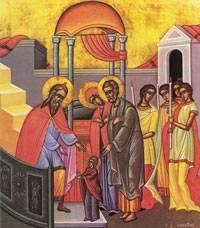 Close with prayer.
Close with prayer.
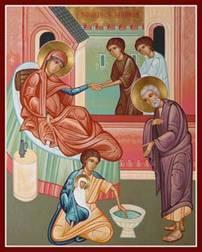
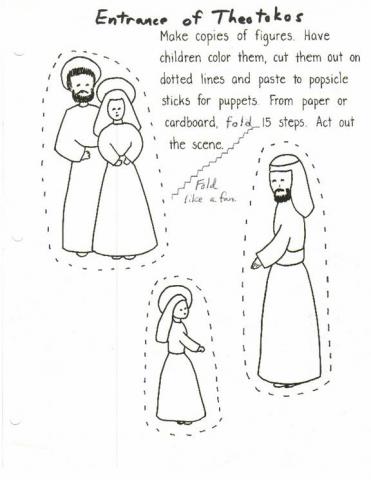
T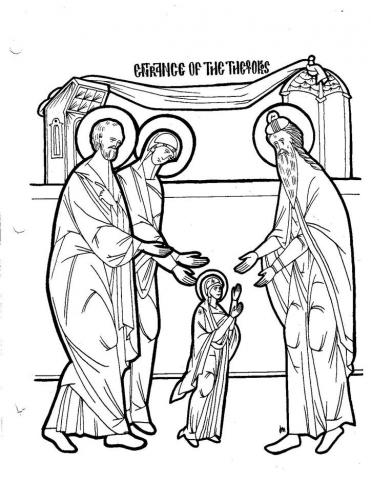
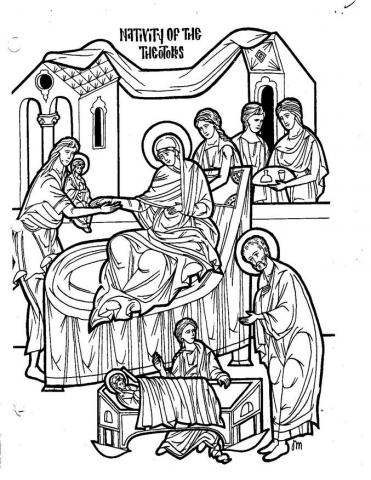
Annunciation
THE ANNUNCIATION
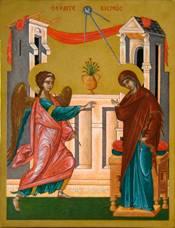
Objectives:
- Children should know that Mary was the mother of Jesus.
- Children should be able to say the word Theotokos and know its meaning.
- Children should be able to say “annunciation” and know it means announcement.
- Children should be able to identify the angel Gabriel and Mary in the icon.
Possible Lesson Plan:
- Open with prayer.
- Read the story of the Annunciation in Beginner’s Bible, pages 266-270, the Children’s Bible Reader, pages 164-165, or Read with Me Bible, pages 252-255. Supplement, if desired, with the Golden Children’s Bible, pages 348-349. Review the story with the icon, identifying Mary and Gabriel. What is Mary holding? She is shown holding a spool of thread because she was spinning thread when the angel appeared to her.
- True/False Questions:
True False
The angel Gabriel appeared to Mary. The angel Michael appeared to Mary
Mary was spinning thread. Mary was playing tag.
Mary was the mother of Jesus Anna was the mother of Jesus.
Annunciation means announcement. Annunciation means birthday.
Add Annunciation to your timeline.
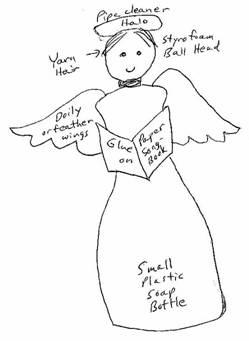 Ask these questions: What was Mary doing when the angel came to talk to her? What would you want to be doing if an angel came to your house? Arguing with your sister or brother? Disobeying your parents? How do you think Mary felt when she saw the angel? How would you feel? Have any of you seen an angel? Why did the angel come to talk to Mary? Who would be the father of Mary’s baby?
Ask these questions: What was Mary doing when the angel came to talk to her? What would you want to be doing if an angel came to your house? Arguing with your sister or brother? Disobeying your parents? How do you think Mary felt when she saw the angel? How would you feel? Have any of you seen an angel? Why did the angel come to talk to Mary? Who would be the father of Mary’s baby?
- Make a Bottle Angel: Take a small dish detergent or similar bottle. Add doily, feather, or paper wings, a strip of paper folded for a book, a Styrofoam head with yarn hair and chenille halo.
- Close with prayer.
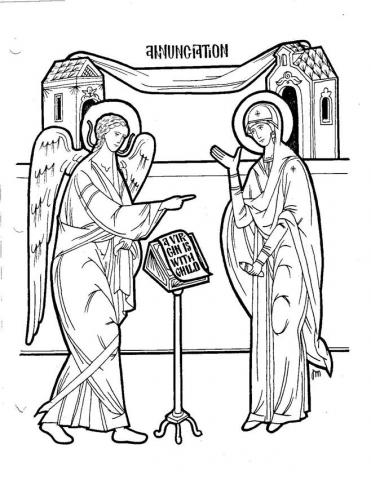
Birth of John the Baptist
BIRTH OF JOHN THE BAPTIST
Objectives:
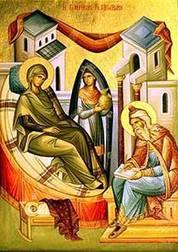 Children should be able to tell the story of Elizabeth, Zachariah , and the angel.
Children should be able to tell the story of Elizabeth, Zachariah , and the angel.- Children should be able to identify John as the child of Elizabeth and Zachariah.
Possible Lesson Plan:
- Open with prayer.
- Read the story of John’s birth in the Childen’s Bible Reader, pages 162-63 and 166-68, or the Golden Children’s Bible, pages 346-350. We also have the Arch book “Elizabeth’s Story”.
- True/False Questions:
True False
Elizabeth and Zachariah were very old. Elizabeth & Zachariah hated children
Zachariah was a priest. Elizabeth was a priest.
The angel Gabriel spoke to Zachariah. The angel spoke to Elizabeth.
Zachariah couldn’t speak. Elizabeth couldn’t see.
Elizabeth & Zachariah’s baby was John. Elizabeth & Zachariah’s baby was
Mary.
Add the Birth of John the Baptist to your timeline:
- First review the stories of other “gift babies”: Mary to Joachim and Anna, Isaac to Abraham and Sarah, and Samuel to Hannah and Elkanah. You can even review the stories in the Read with Me Bible or Children’s Bible. What gift did God give to Elizabeth and Zachariah? How did they feel? What did Zachariah say to the angel? Did he believe God? Do you always believe God? Is it hard sometimes to do what God says? Why couldn’t Zachariah speak? What were his first words? Did he obey God in the end? Who visited Elizabeth before John was born? Remind the students that Mary and Elizabeth were cousins.
- Have another birthday cake and sing “Happy Birthday” to baby John. Can you make up words like a Troparion to go with “Happy Birthday” about John?
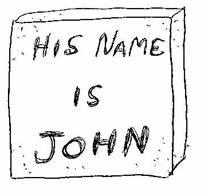 Make a craft: Clay Tablet (like the one Zachariah may have written on). Any of the clays in the recipes or a bought clay should work fine. Shape a tablet. Use a pencil to inscribe the words, “His Name is John”. Why did Zachariah have to write?
Make a craft: Clay Tablet (like the one Zachariah may have written on). Any of the clays in the recipes or a bought clay should work fine. Shape a tablet. Use a pencil to inscribe the words, “His Name is John”. Why did Zachariah have to write?
Close with prayer. Use the prayer that Elizabeth prayed when she saw Mary coming: “Rejoice, O Birthgiver of God, Mary full of grace, the Lord is with you! Blessed are you among women, and blessed is the Fruit of your womb. For you have borne the Savior of our souls!”
Nativity
NATIVITY OF OUR LORD (CHRISTMAS)
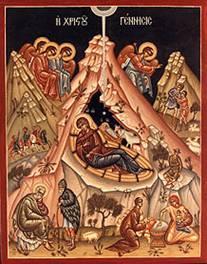
Objectives:
- Children should be able to identify Christmas as Jesus’s birthday.
- Children should know that Nativity means “birthday”.
- Children should be able to tell the story of the Nativity and identify the figures in the icon.
- Children should be able to repeat the greeting: “Christ is born! Glorify Him!”
Possible Lesson Plan:
- Open with prayer.
- Read the story of Christmas in the Beginner’s Bible, pages 271-281, the Children’s Bible Reader, pages 168-170, or the Read with Me Bible, pages 256-265. You can supplement with the Children’s Bible, pages 351-352 or Children’s Stories from the Bible, pages 131-133. Review the story with the children with the icon, having them identify the people, animals, and star and what each did in the story. If you want, print the puzzle icon on cardstock, either large for classroom use or page-size for a take home and tell the story, adding each piece until all are placed.
- True/False Questions:
True False
Jesus was born in a stable. Jesus was born in a palace.
Mary was Jesus’s mother. Elizabeth was Jesus’s mother.
Joseph was Mary’s husband. John was Mary’s husband.
Angels appeared to the shepherds. Goats appeared to the shepherds.
Christmas is Jesus’s birthday. Christmas is Mary’s birthday.
Nativity means birthday. Nativity means play day.
Add Nativity to your timeline:
- Practice the greeting: Christ is born! Glorify Him!” Go around the circle until each child can say each half of the greeting.
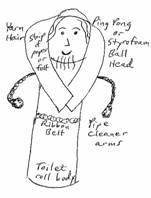 Make a class Creche scene and individual Christmas Stained Glass Windows. For the Creche scene, assign someone to make Mary, Joseph, Jesus, shepherds, and angels. Use toilet paper tubes for figures, with chenille arms and Styrofoam ball head. Use construction paper for the head covering and any clothing. Re-enact the story using your figures. Leave them in the middle of the table for later lessons.
Make a class Creche scene and individual Christmas Stained Glass Windows. For the Creche scene, assign someone to make Mary, Joseph, Jesus, shepherds, and angels. Use toilet paper tubes for figures, with chenille arms and Styrofoam ball head. Use construction paper for the head covering and any clothing. Re-enact the story using your figures. Leave them in the middle of the table for later lessons.
Then make stained glass windows. Cut pieces from tissue paper and lay on a long piece of wax paper, overlapping as needed. Cover with another piece of wax paper and iron lightly.
- Close with prayer.
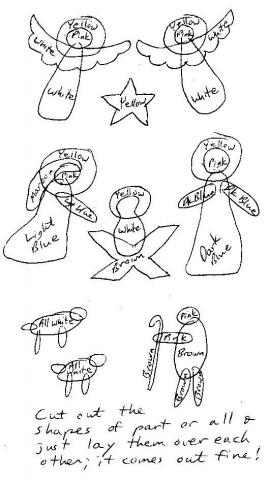
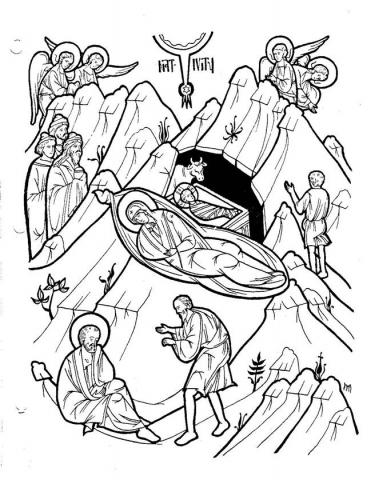
T
The Meeting of the Lord
THE MEETING OF THE LORD
Objectives:
- Children should be able to tell the story of the meeting of the Lord.
- Children should be able to identify Simeon and Anna, as well as Jesus, Mary and Joseph in the icon.
- Children should know what churching is and that this feast is its origin.
- St. Simeon’s prayer is our memory work this week.
Possible Lesson Plan:
- Open with St. Simeon’s Prayer: “Lord, now lettest Thou Thy servant depart in peace according to Thy word, for mine eyes have seen Thy salvation, which Thou hast prepared before the face of all peoples, a light to enlighten the Gentiles, and the glory of Thy people, Israel.
- Read the story of the meeting in the Beginner’s Bible, pages 282-285, the Children’s Bible Reader, pages 173-174, or the Read with Me Bible, pages 266-269. You can supplement with the Golden Children’s Bible. Review the story with the icon, identifying each character. What is the role of each? Why were Simeon and Anna there? Why were Mary, Joseph, and Jesus there? What is Joseph holding and why?
- True/False Questions:
True False
Mary & Joseph brought Jesus to the temple. Mary and Joseph brought Jesus to the playground.
Simeon was an old man. Simeon was an angel.
Simeon and Anna were waiting for Jesus. Simeon and Anna were eating lunch
Simeon and Anna were god-fearing people. Simeon and Anna hated God.
Add the Meeting of the Lord to your timeline:

- Bring an infant baby doll, wrapped in a blanket. Tell the children that each baby is brought to the church when he
or she is a few weeks old. Just as in the days of Jesus, the mothers and fathers thank God for their new child and ask Him to take care of their baby and help him to grow up as a good member of God’s family. This is called churching. Act out a churching, with the teacher as priest, and a little girl holding the baby, a little boy as father.
Priest: Let us pray to the Lord. O Lord God Almighty, Father of our Lord Jesus Christ, purify this woman, (name), from all sin and bless thou the child, (name), who is born of her. (Make the sign of the cross over the child.) As Thou, O Lord, wast brought on the fortieth day as an infant in to the Temple according to the Law by your mother, Mary, and wast carried in the arms of Simeon the Just, do Thou, O Master, bless this baby who is brought here. For unto thee are due all glory, thanksgiving and worship. Amen.
- We bless candles on this feast day. Simeon and Anna were two old people who had been waiting a long time for Jesus, who would be the light of the world. We celebrate the light of Jesus with the blessing of candles. We use candles made of beeswax because God gives us His bees to make the wax. Sing the children's song, "This Little Light of Mine. "
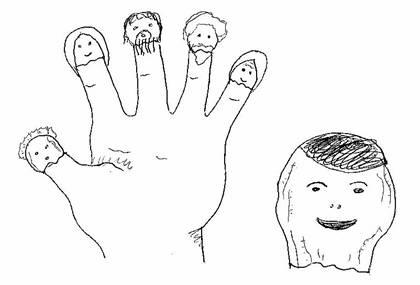 Make Peanut People Finger Puppets: Break peanuts in half for each puppet. Draw on faces and add cloth or paper headcoverings, yarn hair and beards, etc. Practice telling the story with the finger puppets. Someone in the class allergic to peanuts? No problem. Take small strips of paper, tape into cylinders, and decorate in the same way as paper finger puppets.
Make Peanut People Finger Puppets: Break peanuts in half for each puppet. Draw on faces and add cloth or paper headcoverings, yarn hair and beards, etc. Practice telling the story with the finger puppets. Someone in the class allergic to peanuts? No problem. Take small strips of paper, tape into cylinders, and decorate in the same way as paper finger puppets.- Another option if peanuts are a problem: Review all the events surrounding the birth of the Lord with the coloring ornament. Color all the icons, cut on dark lines, fold on dotted lines, and you have a cube. Hang on your tree or in a window!
- You can also use any one of many candle crafts. Take a week-long tall glass votive candle used in your parish. Color the icon picture of the feast and cut to fit. Apply Mod-Podge and attach to candle, covering with thick coat of Mod-Podge on the outside. Use it all week along with the icon of the feast at home or in your sanctuary.
- Close with St. Simeon’s Prayer. Recite the prayer line by line with the children repeating. Or try singing it a couple of times like we do at vespers. Do it all together at the end with lighted candles.
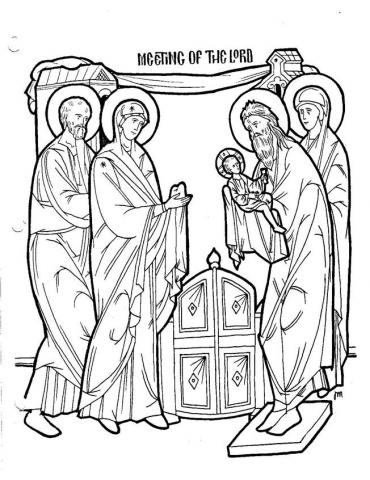
The Three Kings
THE THREE KINGS
Objectives:
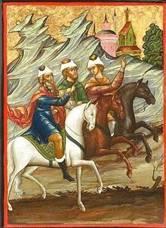 Children should be able to tell the story of the three kings, or wise men.
Children should be able to tell the story of the three kings, or wise men.- Children should know that the star guided the wise men to Bethlehem.
- Children should be able to name Herod as the wicked king who wanted to kill Jesus.
- Children should be able to name the gifts the kings gave the baby Jesus.
Possible Lesson Plan:
- Open with prayer. Review St. Simeon’s prayer. Have the children memorized it yet?
- Read the story of the three kings in the Beginner’s Bible, pages 286-290, the Children’s Bible Reader, pages 170-173, or the Read with Me Bible, pages 270-276. Supplement if desired with the Golden Children’s Bible pages 354-357. Review the icon of the Nativity. Where are the three kings? Add them to your crèche and review all the other figures in the icon and the crèche scene. Does the Bible actually tell us how many kings there were? (no)
3. True/False Questions:
True False
Herod was King of Judea. Herod was one of the wise men.
The kings brought gifts for baby Jesus. The kings hated baby Jesus.
Herod hated baby Jesus. Herod loved baby Jesus.
The kings followed a star. The kings followed a kite.
Jesus was born in Bethlehem. Jesus was born in Baltimore.
4. Ask some questions: What were the gifts of the kings? Why did they bring these gifts? Why did Herod hate Jesus? What did God tell the wise men to do?
Add the Three Kings to your timeline:
5. Make king crèche figures and add to the class crèche scene (see Nativity lesson). Didn't make a class creche scene? Then make the 3 Kings "paper dolls" to stand up. Use cardstock and fold like a fan for three double folds. Place straight edge of pattern along fold, and cut rounded side. When unfolded, the three figures should be stuck together like a paper doll chain. It will stand up by itself. Decorate with markers, sequins, glitter.
6. Then each student can make paper stars; they’ll make great decorations for the Christmas tree.

Alternate craft idea: Lacing stars. Trace the pattern on the following page with yellow poster board and punch out the holes. Give the students large tapestry needles and colored yarn. Have them go in and out, lacing around the outline of the star and then to its center from each point.
7. Close with prayer.
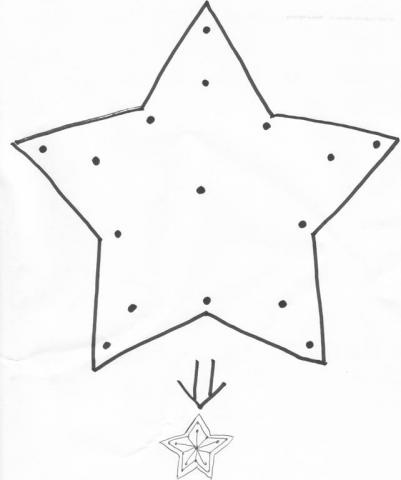
Flight to Egypt
FLIGHT TO EGYPT
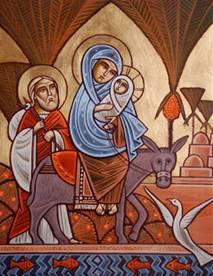 Objectives:
Objectives:
- Children should know how God’s angel helped Joseph care for Jesus.
- Children should know a little about Egypt and Moses.
- Children should recognize Herod as the wicked king who killed the children.
Possible Lesson Plan:
- Open with Prayer.
- Read the story in Beginner’s Bible, pages 291-295, the Children’s Bible Reader, pages 174-175, or the Read with Me Bible, pages 277-279. Supplement if desired with the Golden Children’s Bible, pages 356-357. What did Mary and Jesus ride? Have the children pick the donkey out of the crèche scene. Who warned Joseph? Who wanted to kill Jesus? Why? Where were Joseph and Mary and Jesus living and where did they go? Why Egypt?
- True/False Questions:
True False
An angel warned Joseph about the danger. Joseph heard a warning on the radio.
Mary and Jesus rode a donkey. Joseph, Mary, and Jesus rode a car.
Jesus was born in Bethlehem. Jesus was born in Egypt.
King Herod wanted to kill Jesus. King Herod loved Jesus.
Add the Flight to Egypt to your timeline:
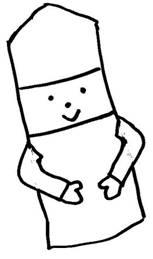 Bring a small suitcase to class. Has any of the children taken a long trip with his family? What for? Explain that it was a long trip to Egypt and the Joseph family had to pack in a hurry to escape the angry king. Re-enact the story, having the children each pretend to put into the suitcase something that the family would need for the journey. What happened in Egypt? Review the stories of Joseph and Moses from the Old Testament briefly. What happened in Bethlehem after they left?
Bring a small suitcase to class. Has any of the children taken a long trip with his family? What for? Explain that it was a long trip to Egypt and the Joseph family had to pack in a hurry to escape the angry king. Re-enact the story, having the children each pretend to put into the suitcase something that the family would need for the journey. What happened in Egypt? Review the stories of Joseph and Moses from the Old Testament briefly. What happened in Bethlehem after they left?
5. Play Pin the Tail on the Donkey: Draw or print large donkey on poster board, or just buy one. Make a construction paper tail for each child. Tape the tail for each child on the donkey with masking or clear tape where it landed, blindfolded of course. Winner gets the donkey?
6. Make Herod’s Soldiers: Take a toilet paper tube. Wrap it with a strip of red construction paper until it’s all covered. Use a thin strip of white paper for the face. Cut the helmet from gray and decorate with red feathers (like Roman soldiers). Cut thin strips of red for arms and glue on tiny white hands. Glue to your soldier. Finish by drawing in the face. Fancy? Decorate the “uniform” with gold metallic ribbon or braid and use chenille pipe-cleaners for arms to hold tiny swords or spears.
7. Close with prayer.
Nazareth and Trip to Jerusalem
NAZARETH AND THE TRIP TO JERUSALEM
Objectives:
- Children should identify Nazareth as the childhood home of Jesus.
- Children should know that Joseph was a carpenter, and so was Jesus.
- Children should be able to relate the story of the trip to Jerusalem and Jesus talking with the elders in the Temple.
Possible Lesson Plan:
- Open with prayer.
- Read the story of Jesus’s childhood in the Beginner’s Bible, pages 296-302,the Children’s Bible Reader, pages 175-177, or the Read with Me Bible, pages 280-285. Supplement if desired with the Golden Children’s Bible pages 358-359. Why did the family come back from Egypt?
- True/False Questions:
True False
Jesus grew up in Nazareth. Jesus grew up in Bethlehem.
Joseph was a carpenter. Joseph was a priest.
Jesus and his family went to Jerusalem. Jesus and his family went to Florida.
Jesus was found in the Temple. Jesus was playing tag on the street.
Add Jesus as a boy to your timeline:
- Discuss the love of our families: How are some ways our parents take care of us? (food, clothing, a house, etc.) How did Mary and Joseph care for Jesus as a boy? (many of same ways) What does your father or mother do at work? At home? What did Joseph do for a living? What’s a carpenter? Do you help your dad? Do you think Jesus helped his dad build things? How do you help your mom? Do you think Jesus did, too? Bring in some wood; we have hammers and nails. Play carpenter for a few minutes.
5. Reenact the journey to Jerusalem: Have children play the roles of Jesus, Mary, Joseph, and caravan members. Travel from your classroom to the sanctuary.
On the road to Jerusalem: Stop and ask “Why are you going to Jerusalem? What are you looking forward to? What do you see on the road?”
In the Temple: Stop and ask, “What are you doing in the Temple?” Have the whole class pray the Lord’s Prayer together in the sanctuary. Jesus stays in sanctuary; rest of class moves to vestibule.
In the vestibule, about ready to go home, ask, “Where are you ready to go now?” Are you happy about your trip to Jerusalem?”
Camping in the playground that night, ask, “Mary and Joseph, what have you just noticed? How do you feel? What will you do?”
Back in the sanctuary, ask, “Jesus, what are you doing? Why did you stay behind? Mary and Joseph, how do you feel now that you’ve found Jesus? Jesus, what do you tell Mary and Joseph?”
Back to the classroom, ask, “Where are we now?” Did we have a good trip?”
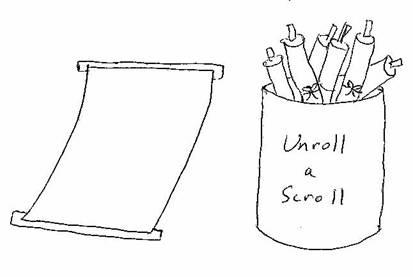 Make a scroll, like the one Jesus might have used as a boy. Use a pencil or a small dowel for each end and glue or tape on the piece of paper. Make several – each with a different picture of Jesus’s boyhood (carpenter, traveling to Jerusalem, in the Temple, at home in Nazareth, etc.)
Make a scroll, like the one Jesus might have used as a boy. Use a pencil or a small dowel for each end and glue or tape on the piece of paper. Make several – each with a different picture of Jesus’s boyhood (carpenter, traveling to Jerusalem, in the Temple, at home in Nazareth, etc.)
6. Alternate craft: Make a "Jesus Left Behind in the Temple" Foldable – print on cardstock the doors with Mary and Joseph and color and cut out. Print the icon on regular paper and cut out Jesus and the elders with their chairs and the floor, leaving Mary and Joseph and the upper background behind. Fold the “card” with both short ends towards the middle like a door. Glue the inside of the temple with Jesus and the elders in the center section. Fold doors shut. Open the doors to see Jesus inside. Re-enact with Mary and Joseph opening the doors to find their Son. Cut the “roof” section to finish the foldable.
7. Close with prayer.
Theophany
THEOPHANY
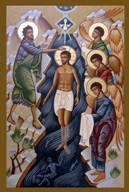
Objectives:
- Children should be able to tell the story of Jesus’s baptism by John.
- Children should name the River Jordan as the site of Jesus’s baptism.
- Children should be able to identify Jesus, John, and the dove in the icon.
Possible Lesson Plan:
- Open with prayer.
- Read the story of Jesus’s baptism in the Beginner’s Bible, pages 303-307, the Children’s Bible Reader, pages 177-179, or the Read with Me Bible, pages 286-289. Supplement with the Golden Children’s Bible, pages 360-361. Review the story with the icon, identifying the characters and their roles. Remind the children that John was Jesus’s cousin. Review briefly the story of John’s birth; do the children remember it? Review the importance of the crossing of the Jordan River in the Exodus from Egypt in the days of Joshua.
- True/False Questions:
True False
Jesus was baptized in the Jordan River. Jesus was baptized in the Temple.
Jesus was baptized by John. Jesus was baptized by Joseph.
John was Jesus’s cousin. John was Jesus’s father.
The Holy Spirit appeared as a dove. The Holy Spirit appeared as a spider.
Add Theophany to your timeline:
- Review the custom of House Blessing. Does any of the children remember their house being blessed? When do we bless houses? Who blesses them? What do we use? Where do we get the Holy Water? Let them know that we will be able to decorate jars for Holy Water today after Church School that they can use for their House Blessing later this year. What do we sing? Practice the Troparion of Theophany with the children.
- Ask the children if they have ever seen a baptism? What’s it like? Why are we baptized? (to become part of God’s family, the Church) Sing together “As many as have been baptized…” How was Jesus’s baptism like our baptisms? Different?
- Make a Come Alive Mural: Draw the icon HUGE on a huge piece of bulletin board paper (or brown wrapping paper). Let the children color the figures, each one concentrating on a particular figure. Cut out the faces and hold the paper up near a wall. You may have to do this in the Social Hall with parents to help hold. Let the children take turns with their faces behind the figures. When everyone’s had a chance, cut up the mural and let each take home his portion.
Too large for your space and time allowed? The Holy Spirit appeared at Theophany in the form of a dove, as we sing in the Troparion. Make a flapping dove string puppet.
- Close with the Troparion and prayer.
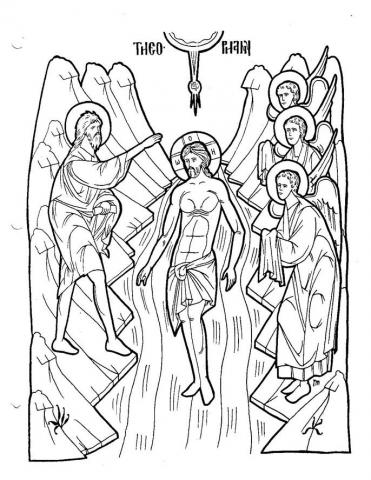
Temptations
TEMPTATIONS
Objectives:
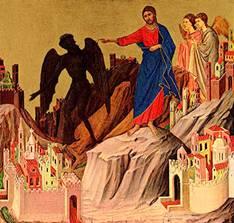 Children should identify the devil, Satan, as the one who tempted Jesus.
Children should identify the devil, Satan, as the one who tempted Jesus.- Children should know that Jesus did not sin.
Possible Lesson Plan:
- Open with prayer.
- Read the Children’s Bible Reader, pages 180-181, Golden Children’s Bible, pages 362-363, or the really good Arch book, “The Temptations of Jesus”. Where did Jesus go after His baptism? What is the desert like? How long did Jesus spend without food and water? What would that feel like? Who is Satan? Review the story of Adam and Eve. What three temptations did Satan present to Jesus? Did Jesus sin?
- True/False Questions:
True False
Satan tempted Jesus. God tempted Jesus.
Jesus went to the desert after His baptism. Jesus went home to Nazareth.
Jesus didn’t eat or drink for 40 days. Jesus had plenty to eat and drink.
Add Temptations to your timeline:
- Ask some questions: Have you ever been tempted to do wrong? To disobey God or your parents? What might tempt you? Did you give in and do the wrong thing? Is it hard to always obey God and your parents?
- Play “Pin the Cross on the Devil”: Make a black paper or poster-board devil and tape it to the classroom wall. Make a small paper cross for each child. Glue a red heart on the devil. Blindfold the children one by one and have them pin or tape their cross to the devil. Whoever is closest to the heart is the winner! Who does the cross represent? Does the cross defeat the devil?
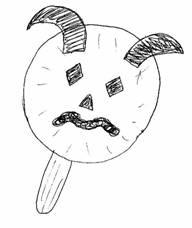
- Make a devil mask: Take a red or black plate. Draw mean-looking features and cut out eyes. Add horns. Tape on Popsicle stick to hold it with. Now pose some situations:
A dollar bill is on the floor.
A friend left her candy on her desk.
I can go to Hershey Park on Sunday morning.
Have the children decide what the devil would say with their devil masks. What would Jesus say to answer the devil?
- Close with prayer.
Wedding at Cana
WEDDING AT CANA
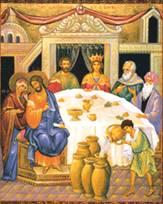 Objectives:
Objectives:
- Children should identify the water into wine as Jesus’s first miracle.
- Children should know the word “miracle” and what it means.
- Children should recognize that the wedding at Cana is part of our wedding service.
Possible Lesson Plans:
- Open with prayer.
- Read the story of the wedding at Cana in the Beginner’s Bible, pages 314-317, the Children’s Bible Reader, pages 184-185, or the Read with Me Bible, pages 295-297. Supplement with the Golden Children’s Bible, page 366. Why was Jesus in Cana? Who asked him to supply more wine? How was the wine supplied? Remind the children that this was Jesus’s first miracle. What is a miracle?
- True/False Questions:
True False
Jesus went to a wedding at Cana. Jesus went to a wedding in Jerusalem
Mary asked Jesus for more wine. The bride asked Jesus for more wine.
Jesus turned water into wine. Jesus turned grapes into wine.
Jesus’s wine was the best ever. Jesus’s wine was sour and nasty.
Add the Wedding at Cana to your timeline:
- Talk a bit about weddings. Has any of the children ever been to one? What happens? Discuss the bride and groom, the service and priest. Play-act a wedding with children as bride and groom, priest, and Jesus and Mary and the other guests. What happens after the ceremony? (reception/party) What’s a party like? What do you like to have at a party? What might grown-ups like to have? What would it be like to run out of drinks with all those guests?
- Usually, there’s singing and dancing at a Jewish wedding. Enjoy some of the dances you learned last week at movie night.
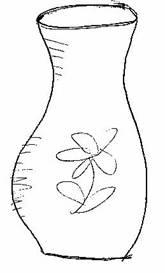
- Make The Steward’s Clay Pots: Take any sort of clay; they sell some nice Mexican reddish air-dry clay at most craft stores. Children love to make things of clay. Try making a pot shaped like a vase. It’s ok to paint on air-dry clay with acrylic paint even before drying if you want to decorate your pots. If you’re able to get a waterproof clay, the pots can be used as vases; otherwise, warn the children to use only silk flowers.
Close with prayer.
Calling of the Fishermen
- CALLING OF THE FISHERMEN
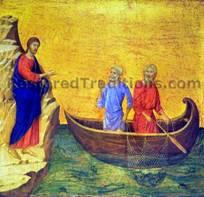 Objectives:
Objectives:
- Children should be able to name the four fishermen.
- Children should be able to tell the story of the miracle of the full nets.
- Children should be able to say the word “disciple” and know that Jesus’s disciples were His closest followers.
Possible Lesson Plan:
- Open with prayer. After prayer, why not provide a "fish in a net" snack to eat while telling the story? Take small curly pretzels, or even better "windowpane pretzels", provide icing colored blue for children to dab on the pretzel, stick a goldfish snack into the blue "water" and let the children eat their "fish" in the "net" for their own "catch" while discussing.
- Read the story of the calling of the fishermen in the Beginner’s Bible, pages 308-310, the Children’s Bible Reader, pages 182-184, or the Read with Me Bible, pages 290-293, or the Golden Children’s Bible, pages 364-365. When did Jesus first meet Andrew? (He was a follower of John the Baptist.) Why is Andrew called the “First-called”? Who was Andrew’s brother? (Simon, later named Peter by Jesus) Who were the sons of Zebedee, also brothers? (James and John) What do you think Peter said when he saw all those fish in his net? Why did the fishermen give up fishing to follow Jesus?
- True/False Questions:
True False
Andrew was the first called. Peter was the first called.
Peter and Andrew were brothers. Peter and John were brothers.
James and John were sons of Zebedee. Peter & James were sons of Zebedee.
Add Fishers of Men to your timeline:
- Talk a bit about being a disciple. What is a disciple? Repeat the word until the children know it. Jesus had 12 close disciples, but many followers. What did the fishermen have to do to become Jesus’s disciples? Did they enjoy fishing? How do you think they felt leaving their homes and families? Was it easy being a disciple? We are also Jesus’s disciples. What does Jesus ask us to do? Is it always easy?
- Begin to list and memorize the 12 disciples: Peter and Andrew, James and John, Matthew, Philip and Nathaniel Bartholomew, Simon the Zealot, JAdd ames (the Less), (Doubting) Thomas, Judas, and Judas Iscariot. Here’s a song to the tune of “Old McDonald” that may help:
Peter, Andrew, James, and John, fishermen were they.
Simon Zealot, James the Less, Judas Thaddeus.
With Philip and Nathaniel Bartholomew,
Doubting Thomas and Taxman Matthew,
Judas Iscariot last of all; he the Lord betrayed.
- Make Fishers of Men. Cut out about 20 fish for each child. Write the name of a disciple on 12 of them and other names on the rest. Clip a paperclip to each fish. Make a fishing pole with pencil, string, thumbtack, and a piece of magnet for a hook; almost any magnet will do, even the self-adhesive kind. To play the game, put the fish in a bowl. Catch a fish with the magnet and pull it up. The child should decide whether the name is a disciple or not. Keep the disciples and throw the rest in a pile as discards. Continue until all fish are caught.
- Close with prayer.
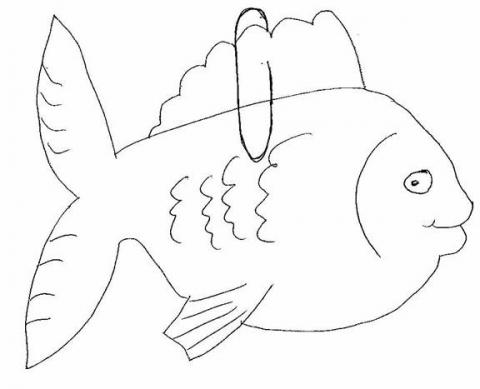
Calling of Matthew
CALLING OF MATTHEW
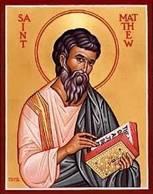
Objectives:
- Children should know that Matthew was a tax collector.
- Children should know that Matthew was one of Jesus’s disciples.
- Children should memorize the 12 disciples.
Possible Lesson Plan:
- Open with prayer.
- Read the story of Matthew in the Beginner’s Bible, pages 311-313, or the Read with Me Bible, page 294. Supplement with the Golden Children’s Bible, pages 370-371, or the Arch book, “The Man Who Learned to Give”. What was Matthew’s job? Was he liked by most people? Why or why not?
- True/False Questions:
True False
Matthew was a tax collector. Matthew was a doctor.
Jesus went to Matthew’s house. Jesus hated Matthew.
Matthew was Jesus’s disciple. Matthew hated Jesus.
Matthew gave back the money he stole. Matthew stole Jesus’s money.
Add Matthew, the Tax Collector, to your timeline:
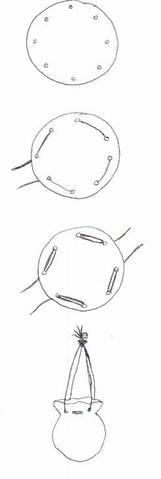 Talk a bit about liking people: What makes someone a good friend, a nice person? Have the children come up with some characteristics. What makes someone a “bad” person? Did most people think Matthew was a nice person or a bad person? Why? Did most people like Matthew? Did they visit him? Were they nice to him? How did Jesus treat Matthew? Do you know some people who are not so nice? How do we treat people who are not so nice? Are we being like Jesus?
Talk a bit about liking people: What makes someone a good friend, a nice person? Have the children come up with some characteristics. What makes someone a “bad” person? Did most people think Matthew was a nice person or a bad person? Why? Did most people like Matthew? Did they visit him? Were they nice to him? How did Jesus treat Matthew? Do you know some people who are not so nice? How do we treat people who are not so nice? Are we being like Jesus?
- Make a Money Pouch: Take a circle of leather or heavy fabric or felt. Cut 8 holes around the top. Use 2 shoelaces or heavy yarn or twine for each pouch and lace around the top, one in each direction. Pull tight and knot drawstring. Decorate the outside with fabric markers or acrylic paint if desired.
Alternate Craft: Work instead on learning the names of all the disciples, now all called by our LOrd with the addition of Matthew. Use popsicle sticks and glue dots, allow the students to write in the names or do it ahead of time with a sharpie, decorate with faces and color the rest of the popsicle stick, and glue to the carrying stick to get the entire project home and display it.
- Close with prayer: Lord Jesus, help me to love even people who are not nice to me and to be like You.
Woman at the Well
THE WOMAN AT THE WELL
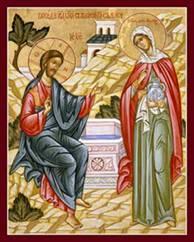 Objectives:
Objectives:
- Children should be able to tell the story of Jesus and the woman at the well.
- Children should be able to say the word, “evangelism” and know that it means telling people about Jesus.
Possible Lesson Plan:
- Open with prayer.
- Read the story of the woman at the well in The Zondervan Bible Storybook (2 copies total) on page 246. It is not in the Read with Me or the Children’s Bible. Or read the story here, using the icon for your illustration:
-
The Story of the Woman at the Well
Jesus was tired. He was on a long journey and was resting by the well when a
woman arrived. When the woman started to draw water, He said, “Give me a drink.” The command shocked the woman because Jews didn’t associate with Samaritans. Jesus was a Jew and she was a Samaritan.
“How is it that You, a Jew, ask for a drink from me, a Samaritan woman?”
“If you knew the gift of God,” He said, “and who is saying to you, ‘Give me a drink,’ you would ask Him and he would give you living water.”
His words confused her.“Sir, you don’t even have a bucket, and the well is deep. So where do you get this living water? You aren’t greater than our father Jacob, are you?”
Could she dare to hope that this man was truly different? Maybe he could give her something that would take away her emptiness and shame. If He was greater than Jacob, who had given them the well, maybe there really was hope for her.
But then Jesus asked about her past. He asked the woman about her sin, revealing He knew EVERYTHING! How could he know? Was Jesus a prophet? She began to ask him questions about spiritual things.
“…An hour is coming,” He said, “when the true worshipers will worship the Father in spirit and truth. Yes, the Father wants such people to worship Him. God is spirit, and those who worship Him must worship in spirit and truth.”
The woman said, “I know that Messiah is coming… When He comes, He will explain everything to us.” Jews and Samaritans were both waiting for the Messiah promised in the Old Testament.
To the woman’s great surprise, Jesus replied, “I am He, the One speaking to you.”
His words hung in the air, and the woman could feel her heart rise up. Her thoughts swirled! Was she really speaking to the Messiah? Is that how He knew everything about her? She had to go and get others!
The woman went into the town and brought those she had avoided before to hear Jesus. Soon they, too, believed Jesus was the Messiah they had been waiting for!
That day, salvation came to those who believed and the Samaritan woman’s past was forgiven. Jesus knew her, even before she spoke a word, and Jesus knows you, too. He knows everything you have ever done… the good and the bad, and He loves you anyway. You can also know God and worship Him with your whole heart just like the woman at the well!
- Why was Jesus at the well? Where were the disciples? What was the woman doing? What did Jesus say to her? What did she do?
- True/False Questions:
True False
Jesus was sitting at a well. Jesus was sitting in his car.
A woman came to draw water. A woman came to buy a goat.
She went and told everyone to come. She went home for a nap.
Add the Woman at the Well to your timeline:
- Talk a bit about evangelism: Say the word and repeat it until the children know it. What does it mean? Was that what the woman at the well did? Was she excited to tell her friends what Jesus had said? Is there anyone you know who does not know about Jesus? Have you told them? Why or why not?
- Make the Woman at the Well Game: Cut several jars for each student. Write on each a question about the woman at the well. Make a well from a 28-32 oz. tin can; the outside can be covered with gray construction paper and lines drawn like stone. Tie a string to a small hole in each jar and put the jars in the well with the strings hanging over the side. See if the student can answer the questions drawn from the well.
- Close with prayer. Lord Jesus, make me so excited that I want to tell everyone about you, like the woman at the well.
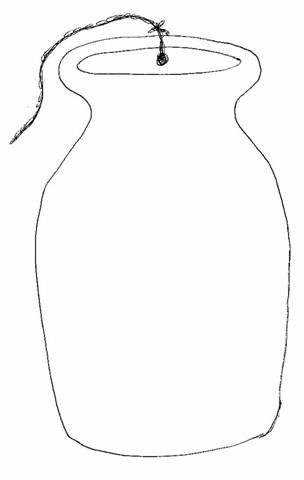
Sermon on the Mount
SERMON ON THE MOUNT
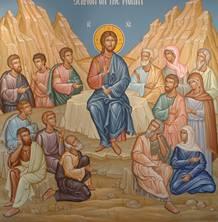 Objectives:
Objectives:
- Children should know that the Sermon on the Mount is full of teachings of Jesus.
- Children should be able to list several important teachings of Jesus: the light of the world, the salt of the earth, the sparrows and lilies, the house on the rock, etc.
Possible Lesson Plan:
- Open with prayer.
- Read the Beginner’s Bible, pages 318-321, the Children’s Bible Reader, pages 193-197, or the Golden Children’s Bible, pages 376-383. There is also an Arch book in the cabinet about the Beatitudes. All classes are working on the Beatitudes; this class will also focus on the story of the birds, the grass, and the lilies.
- True/False Questions:
True False
Jesus cares about the birds. Jesus hates birds.
God cares for the grass and flowers. Jesus hates grass and lilies.
God cares for us. We have to take care of ourselves.
Add the Sermon on the Mount to your timeline:
- Discuss Nature: Who created plants and animals? Does God love His creation? What do plants need to grow and not die? Brainstorm some ideas – water, light, soil, etc. What do birds need to grow and not die? Brainstorm again – food (what type?), water, nests, etc. How does God provide these? What does the grass have to do? The lilies? The sparrows? What do people need to grow and not die? (food, drink, clothing) How does God provide these things? Will He? Why? Do we need to worry?
- Begin to memorize the Beatitudes. Say or sing it together to begin the memory work to be continued at home. Can each child say it? Go over line by line, reading it to the children:
What is “poor in spirit”? What is the kingdom of heaven like?
When do we mourn? What does God do when we are sad?
Who is meek, or gentle? Does it look like they would inherit the earth?
Do we hunger and thirst after righteousness, really? Are we truly satisfied?
What is mercy? Are we merciful? When? Do we need mercy?
What does “pure in heart” mean?
Who is a peacemaker? What makes them a peacemaker?
What does “persecuted” mean? Have you ever been persecuted for being a Christian?
Has anyone ever told a lie about you? Does it hurt? Did you rejoice?
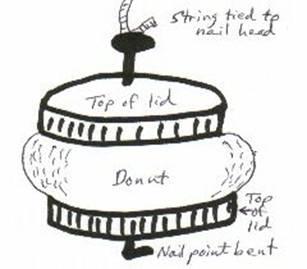
- Make a bird feeder. Take 2 jar lids and a cake donut. Punch a hole through the jar lids. Add the donut. Use a bent nail to hold it all together and tie a string to hang it in your backyard. Replace the donut as needed. Are you helping God to care for the birds?
- Close with prayer. Use the Lord’s Prayer, also from the Sermon on the Mount.
Walking on Water and Calming the Storm
WALKING ON WATER AND CALMING OF STORM
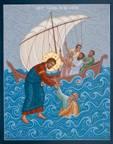 Objectives:
Objectives:
- Children should be able to tell the story of the two miracles in their own words.
- Children should be able to identify Peter as the disciple who walked on water.
Possible Lesson Plan:
- Open with prayer.
- Read the stories of the miracles in the Beginner’s Bible, pages 334-339 and 364-370, the Children’s Bible Reader, pages 193-197, or the Read with Me Bible, pages 304-307 and 318-323. Supplement, if desired, with the Golden Children’s Bible, page 404, the Arch book, and the flannelgraph story. What was Jesus doing in the boat when the storm came? How did the disciples feel? How did Jesus respond? Who came walking across the water? Who wanted to walk with Jesus? What happened when Peter looked down? How did Jesus respond?
- True/False Questions:
True False
Jesus was sleeping thru the storm. Jesus was afraid of the storm.
The disciples were afraid of the storm. The disciples loved storms at sea.
Jesus told the wind to be quiet. The boat sank.
Peter walked with Jesus on the water. John walked with Jesus on the water.
Snack today? Try Stormy Seas Jello – Make blue jello ahead of time in individual cups. Spray with whipped cream for clouds. Add piece of chocolate bar for boat, with whipped cream sail. Sprinkle with Swedish fish.
Add Jesus in the boat in the storm to your timeline:
- Talk a bit about storms: What are storms like? Lightning? Thunder? Wind? Bring some library books with pictures of storms or try making a storm in the room by turning out the lights, blinking them, and beating on a pot. Make a “storm dish”: Fill pie pan (or other shallow pan) with water. Add some blue food coloring and a tablespoon of vinegar. Float a small plastic boat in the water. Sprinkle a small amount of baking soda into the water like rain. Watch the “storm” of bubbling waves and the boat. Have the children imagine they are in a storm. Are you afraid of the thunder or lightning? Why or why not? Is God in charge of the world even in a storm? Can we trust God? What is water like? Think about swimming a bit. How do we keep from sinking? Can we breathe under water? Do you like to swim? Can we walk on water usually? Why could Jesus walk on the water? (He trusted God.) Did Peter trust Jesus? Completely? Is God in charge even of the water? Can we trust God?
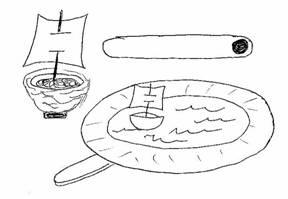
- Make a Sailing Boat: Take a paper plate and color it blue. Make a tiny boat with a half walnut shell (or plastic bottle top), clay or play-doh, a toothpick, and a tiny piece of paper or fabric. Stick a piece of adhesive magnet strip on the bottom of the boat and another on the end of a Popsicle stick. Now use the Popsicle stick below the plate “sea” to make the boat “sail” around.
6. Too many things to deal with and purchase? Try the “Peace, Be Still! stormy sky” instead. Print the boat with waves on cardstock and cut out ahead of time for the students of this age. Glue the bottom and sides to black construction paper. Then print with cardstock the storm wheel. Use a brad to mount the storm wheel beneath the boat. Turn the wheel to tell the story.
Your class loves to color and cut and do things themselves? Cut out the black and white boat and color it. Then cut waves from blue paper. Glue boat the top of waves and waves to bottom of black construction paper, again only gluing on sides and bottom. Now take a paper plate and color the BOTTOM, one half to be stormy night sky and the other starry night sky, perhaps with some stickers? Mount paper plate as above with the brad. Write on the waves, “Peace, be still!”
7. Close with prayer, asking God to help us trust Him even in a storm.
Feeding the 5000
FEEDING THE 5000
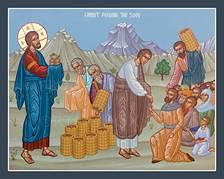
Objectives:
- Children should identify this as a miracle of Jesus.
- Children should know the little boy shared 5 loaves and 2 fishes.
- Children should know that Jesus fed 5000 people after blessing the food.
Possible Lesson Plan:
- Open with prayer.
- Read the story in the Beginner’s Bible, pages 357-363, the Children’s Bible Reader, pages 210-211, or the Read with Me Bible, pages 312-317. Supplement, if desired, with the Golden Children’s Bible, pages 402-403 or the Arch Book, “The Boy Who Gave His Lunch Away”. What was Jesus doing? Why were so many people there? They must have been hungry. What did Jesus feed them? Where did He get the food? What did Jesus do with it? What was left over? Was this a miracle? How did the disciples feel?
- True/False Questions:
True False
Jesus was teaching in the wilderness. Jesus was in a restaurant.
The little boy had 5 loaves and 2 fish. The little boy had a steak and peas.
Jesus fed 5000 men from the blessed food. Jesus sent the people to town to buy
food.
Add Five Loaves and Two Fishes to your timeline:
- Try a sharing demonstration. Bring to class a batch of brownies, enough for half the class. Hand out the brownies to half the students; let the others see that there are no more. Are there comments about not being enough? Ask the children what they can do about this situation. When they come up with the answer, cut each brownie in half. Now there are enough for everyone. Eat the brownies while you talk about sharing: Did the little boy have to share his food? Why did he share? No one forced him to share his food – he wanted to. Jesus teaches us to share food with others. Do you bring lunch or snack to school? What if someone asks for something especially delicious from you? Will you share? Are there other ways we can share? Think about some and write them down.
- Make a Fish and Loaves Plate: Cut out 2 fish and 5 loaves for each student from the patterns. Write on each something the student has said he can share. Bend the tabs and tape to a paper plate, writing on the plate “I Can Share”.
- Close with prayer, asking Jesus to help us to be sharing people, as was the little boy. Pray specifically for the areas the children have said that they are willing to share.
 FISHES AND LOAVES PATTERNS
FISHES AND LOAVES PATTERNS
Transfiguration
TRANSFIGURATION
Objectives:
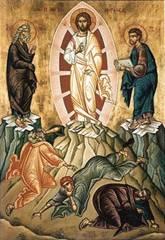 Children should be able to tell the story of the Transfiguration.
Children should be able to tell the story of the Transfiguration.- Children should be able to say the word “transfiguration” and know that it means “Change”.
- Children should be able to identify each character in the icon and his role in the story.
Possible Lesson Plan:
- Open with prayer.
- Read the story of the Transfiguration in the Children’s Bible Reader, pages 218-219, or the Golden Children’s Bible, pages 406-407. It is not in the Beginner's Bible at all. Show the icon. Have the children identify the figures and retell the story in their own words using the icon. Say the word “transfiguration” several times until the children can repeat it easily. What does it mean? Who was transfigured? In what way? Who did Jesus speak to? Which disciples came with Him?
- True/False Questions:
True False
Jesus shone with dazzling white robes. Jesus turned pink and purple.
Peter, James, and John came with Jesus. Mary and Joseph came with Jesus.
Jesus spoke with Moses and Elijah. Jesus spoke with King Herod.
Add Transfiguration to your timeline:
- Review the Old Testament stories of Moses and Elijah; both are in the Read with Me and Children’s Bible. Why would God have chosen these two men for Jesus to speak to? What was their importance in the Jewish history? Both are considered to be forerunners of Jesus. Many people thought that John the Baptist was Elijah come back to life. How was John like Elijah? How was Jesus like Elijah? How was Jesus like Moses?
- The Feast of theTransfiguration is celebrated on August 6. We bring fruit to church on the feast. Why? We are asking God to bless the harvest of fruit and the crops, which are just becoming ripe at this time.
- Make a Transfiguration Diorama. Use pipe-cleaners with a little clay on the bottom for figures. D
 raw your background on a piece of paper and glue into a shoebox or similar-size container. Green felt makes nice grass on the bottom. What are the figures carrying? Make clothing, if desired, of small bits of felt or cloth. Construction paper will do nicely for “props”.
raw your background on a piece of paper and glue into a shoebox or similar-size container. Green felt makes nice grass on the bottom. What are the figures carrying? Make clothing, if desired, of small bits of felt or cloth. Construction paper will do nicely for “props”. - Too much time? Use the pop-up diorama on the next page. Take 1 piece of light blue cardstock and draw the mountain background and color. Cut 3 more pieces of cardstock, perhaps light blue but any color, like a frame with 1-inch borders. Take the centers you removed, cut in half, and fold them like fans and glue to short sides, adding one level at a time. Time limited? Do this step ahead of time and glue will be dried and ready for the students. Print the icon on cardstock. Color. Cut out Jesus, Moses, and Elijah, color and glue them on the back, on the mountaintop. Cut out the disciples and glue them on the bottom at different levels near the front. Don’t forget to glue cotton ball clouds in the sky, and perhaps some Easter grass on the front 2 bottom panels! Write Transfiguration along the top of the front panel.
- Close with prayer. Ask God to bless the fruit and crops now and every year.

Good Samaritan
THE GOOD SAMARITAN
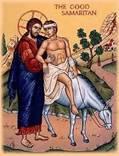 Objectives:
Objectives:
- Children should be able to identify this story as a parable of Jesus.
- Children should be able to tell the story in their own words.
- Children should have an understanding of what makes a good neighbor.
Possible Lesson Plan:
- Open with prayer. Use the Lord’s Prayer. Recite it a couple of times for memory practice.
- Read the story of the Good Samaritan in the Beginner’s Bible, pages 379-384, the Children’s Bible Reader, page 202, or the Read with Me Bible, pages 324-328. Supplement, if desired, with the Golden Children’s Bible, pages 412-413. Review the meaning of a parable, a story with a hidden meaning. Why did Jesus tell this story? What happened to the man in the story? Was the priest a good neighbor to this man? The Levite? Why or why not? Was the Samaritan man a good neighbor to the hurt man? Why?
- True/False Questions:
True False
The man was traveling to Jericho. The man was traveling to Bethlehem.
The man was hurt by robbers. The man had a safe and boring trip.
The priest passed the man without helping. The priest helped the man.
The Samaritan man helped the hurt man. The Samaritan hated the hurt man.
Add the Good Samaritan to your timeline:
- Discuss the concept of “neighbor”: Ask the children who are their neighbors. After a listing of friends and neighbors, try to expand their focus. Is the homeless man in the street who smells bad and is dirty also a neighbor? Is the child who steals their lunch money also a neighbor? Is the boy who hits them on the playground also a neighbor? Did Jewish people usually like Samaritans? Did Samaritans usually like Jewish people? Remind the children that the Samaritans were the descendants of the people who were not taken into Babylon in captivity; they married people of the land and were hated by the Jews when they returned. Was it easy for this Samaritan man to care for the Jewish man? Is it always easy to love other people and to do good things for them? Is there someone you find particularly difficult to love? Can you do something nice for them as a good neighbor?
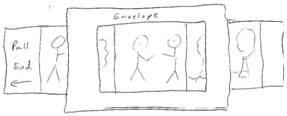 Make an Envelope Viewer Movie Strip. Cut a TV screen hole in the front of a business-size envelope. Lick the envelope shut and cut off both ends. Give each student a strip of paper divided comic-strip style into about 6 frames. Have them illustrate the story of the Good Samaritan; what are the most important scenes? Insert the strip in the viewer and pull through to see the whole story. Can they tell the story with their “movie”?
Make an Envelope Viewer Movie Strip. Cut a TV screen hole in the front of a business-size envelope. Lick the envelope shut and cut off both ends. Give each student a strip of paper divided comic-strip style into about 6 frames. Have them illustrate the story of the Good Samaritan; what are the most important scenes? Insert the strip in the viewer and pull through to see the whole story. Can they tell the story with their “movie”?- Close with prayer. Have each child think of a particular person who is hard to love and pray for that person and plan something nice for that person.
Parable of the Sower
PARABLE OF THE SOWER
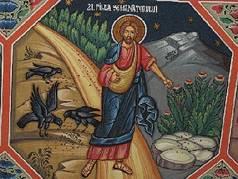
Objectives:
- Children should be able to tell the story of the parable in their own words.
- Children should know the word, “parable”, and be able to say that it is a story with a hidden meaning.
- Children should know the “hidden meaning” of the seeds and the sower.
Possible Lesson Plan:
- Open with prayer.
- Read the story of the sower in the Golden Children’s Bible, pages 392-393, and the really fun Arch book, “Seeds that Grew”. Tell the children that Jesus is telling a story. It is a special kind of story. It is called a parable. Repeat the word until the children know it. What is a parable? In this parable, who is the sower? What are the seeds? What is the soil?
- True/False Questions:
True False
A parable is a story with a hidden meaning. A parable is a comic strip.
The sower is Jesus or God. The sower is the devil.
The seeds are God’s words or teachings. We are the seeds.
We are the soil. God is the soil.
Add The Sower to your timeline:
- Try to understand the parable a bit: What kind of people are hard, rocky ground? Would seeds grow well there? What kind of people are easily dried out by the hot sun? Would seeds grow well there? What kind of people are so shallow the birds can eat the seeds? What kind of things might be thorns that take over our lives? What kind of people are rich soil? What kind of people are each of us? This will be hard with smaller children; they may remain totally concrete, unable to see people as dirt and teachings as seeds. That’s OK; talk about seeds and dirt and later understanding will come.
- Make a Seed Starter Station: Take an egg carton, preferably paper. Fill with soil. Plant various seeds in the different pockets, or try to do an experiment based on the parable – two pockets with only rocks, two with almost no soil, another 2 with lots of weed seeds (e.g. grass), and the rest with deep soil and pretty flower seeds. Have the children take their “science experiment” home, water it, and watch the growth.
- Close with prayer, asking Jesus to make us good soil to learn and obey His teachings.
Zaccheus
ZACCHEUS
 Objectives:
Objectives:
- Children should be able to identify Zaccheus as the short man who wanted to see Jesus.
- Children should know that Zaccheus’s life was changed by meeting Jesus.
Possible Lesson Plan:
- Open with prayer.
- Read the story of Zaccheus from the Beginner’s Bible, pages 413-417, the Children’s Bible Reader, page 224, or the Read with Me Bible, pages 356-357. Supplement with the Golden Children’s Bible, page 422, if desired. What did Zaccheus do for a living? Do we know another tax collector in the Bible? (Matthew, the disciple) Why couldn’t Zaccheus see Jesus? What did he do? What did Jesus say to Zaccheus? What did Zaccheus do for Jesus?
- True/False Questions:
True False
Zaccheus was a tax collector. Zaccheus was a priest.
Zaccheus was a short man. Zaccheus was the tallest man in town
Zaccheus climbed a tree. Zaccheus flew in a balloon.
Jesus went to Zaccheus’s house. Jesus walked right by Zaccheus.
- Sing the song “Zaccheus was a wee little man…”
Add Zaccheus to your timeline:
- Look around the room: Who is tall? Who is short? Who has blond hair? Who has dark hair? Who has blue eyes? Who has brown eyes? Have children brainstorm other physical characteristics that make us uniquely ourselves. Does God love only tall people? Brown-haired people? Blue-eyed people? God loves everyone! God loves each of us, just like we are!
- Talk a bit about hard work and persistence: Do you remember the fairy tale of the fox and the grapes? The fox found a bunch of grapes, but they were too high for him to reach, so he told everyone that they were sour. Did Zaccheus give up on seeing Jesus just because he was too short? Did he just tell people Jesus wasn’t worth seeing? Zaccheus found a way to his goal. What did he do? He climbed a tree. Was that easy? Wouldn’t it have been much easier to just go home and say that Jesus wasn’t worth the effort. What did Zaccheus receive for his hard work and persistence? Did he only see Jesus as Jesus walked by? No, Jesus stopped, called Zaccheus, and went to his house for dinner!
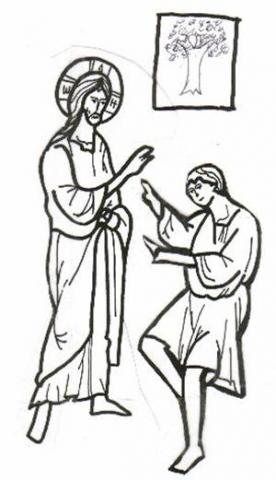 Make Popsicle Puppets: Take the Zaccheus and the Jesus patterns. Color and cut out. Tape Popsicle stick to the back. Have students take a piece of light blue construction paper. Cut out a brown tree trunk and green leaves. Glue to make a tree. Use this as your background to tell the story with your puppets.
Make Popsicle Puppets: Take the Zaccheus and the Jesus patterns. Color and cut out. Tape Popsicle stick to the back. Have students take a piece of light blue construction paper. Cut out a brown tree trunk and green leaves. Glue to make a tree. Use this as your background to tell the story with your puppets.
8. Print the Pre-Lenten Path for the children to take home and color one square each day until Great Lent.
- Close with prayer.
Publican and Pharisee
THE PUBLICAN AND THE PHARISEE
Objectives:
- Children should be able to say the words “publican” and “Pharisee” and know their meanings.
- Children should know whose prayers God listened to and why.
Possible Lesson Plan:
- Open with prayer.
- Read the story in the Zondervan Bible Storybook, one available in each classroom. Don’t have it? The story goes like this: Jesus told a story called a parable to the people. A parable is a story that teaches a lesson. This story is about two men who both went to the temple to pray. A temple is like a church. One of these was a Pharisee. Can you say “Pharisee”? A Pharisee was a man who spent his life studying the law of Moses and praying. He wore special clothes that told everyone he was a Pharisee. But this man came to the temple bragging to God about how good he was, and how wonderful were the things that he did, and how he wasn’t at all like other men. He stood tall with his own pride in all his deeds for God. His prayer was full of self-love, not love of God.
Another man was there. He was a Publican. Can you say “Publican”? A publican was a tax collector. In that day, some men collected taxes for the hated Romans and often stole some of the money for themselves. This man was sorry for his sins. He asked God to forgive him for his sins. He was so sad, he couldn’t even raise his head off the ground.
Jesus asked the people which prayer was heard by God? The Pharisee or the Publican? Of course, God would listen to the prayer of a holy man like the Pharisee, but not that of a hated tax collector. Jesus told the people that God honored the prayer of the tax collector who humbled himself before God and not the prayer of the Pharisee, full of pride and self-love.
- What is a publican? Who else have we met who is a tax collector? (Zaccheus and Matthew) Review their stories briefly. What did the publican pray? What is a Pharisee? (a respected man of the temple) What did he pray? Which did God listen to? Why?
Add the Publican and the Pharisee to your timeline:
- True/False Questions:
True False
A publican is a tax collector. A publican is a teacher.
A Pharisee is a respected man of the temple. A Pharisee is a garbage collector.
God listened to the prayer of the publican. God listened to the Pharisee.
- Talk a bit about humility: How do you feel when you win a race? Get a prize? Do something good? This feeling is called pride. Some pride is OK. But the Pharisee had done many good things – so many good things that he was always bragging about himself, even to God! Do you ever brag when you do something good? How does it make you feel? How does it make other people feel? Do you feel like you’re better than other people? Does it look that way when you brag? Did the Pharisee think he was better than the publican? Was he in God’s eyes? Have you ever done anything wrong – ever disobeyed God or your parents, cheated in school, hit your brother, yelled at your sister, etc.? None of us is perfect; we all make mistakes. When we pray, should we brag, or should we ask God to help us obey Him even better? Remember the Beatitudes: can anyone recite “Blessed are the poor in spirit…” Which was poor in spirit – the publican or the Pharisee? Which will inherit the kingdom of heaven?

- Make “Bible Bookends”: Copy the icon and cut out 2 Pharisees and 2 publicans; you’ll have to draw in just the bottom of the Pharisee where the Publican overlays it. Have the students color the pieces. Take a brick. Spray paint it or glue felt on each side. Glue felt on the bottom. Glue the Pharisees on the wider side and the Publicans on the smaller sides. The bookends will remind the students each day of the parable and its moral.
- Close with prayer.
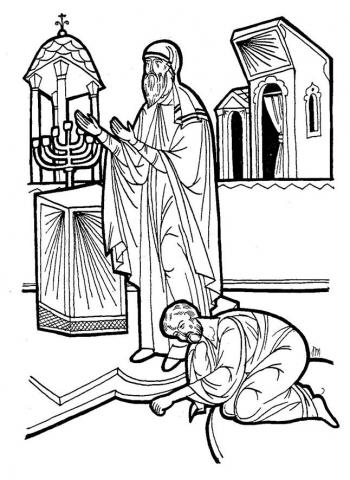
Prodigal Son
THE PRODIGAL SON
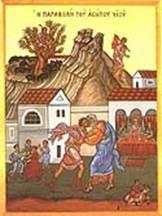 Objectives:
Objectives:
- Children should be able to tell the story of the Prodigal Son in their own words.
- Children should know that God forgives us even when we do something we shouldn’t.
Possible Lesson Plan:
- Open with prayer.
- Read the story of the Prodigal Son in the Beginner’s Bible, pages 397-404, the Children’s Bible Reader, pages 207-209, or the Read with Me Bible, pages 344-349. Supplement with the Golden Children’s Bible, pages 416-417, if desired. Where did the son go? What did he do with his money? Where did he end up, doing what? Why did he go back to his father? What did he say? What did his father say?
- True/False Questions:
True False
The son left home with his money. The son stayed home with daddy.
The son spent all his money. The son saved his money carefully.
The son had to feed the pigs. The son worked in the market.
The father was happy the son came home. The father hated the son.
Add the Prodigal Son's Pig to your timeline:
- Talk a bit about the words “I’m sorry”: These are powerful words. When do we say them? Have the children think of some times they have said them or heard someone else say them. What do we mean by saying “I’m sorry”? Did the Prodigal Son say, “I’m sorry”? How did the father respond? How do we respond when someone says they are sorry? Sometimes it’s not so easy to forgive. What if your friend broke your favorite toy and said, “I’m sorry”? Is it easy to forgive when the toy is still broken?
- Take a pigpen pledge: Review the story. The Prodigal Son was in the pigpen. He realized his sin and his father’s love – then he had to take a step. He had to get up and leave the pigpen and take a step towards his father! Picture this with the students. Then have each in preparation for Lent consider his or her own pigpen. What one single step can he or she take during Great Lent to move towards the Lord? Increased prayer time? Scripture reading each day? Lenten services? Improved fasting? Visiting the sick? Let each student actually write down the step he will take to draw nearer to the Father.
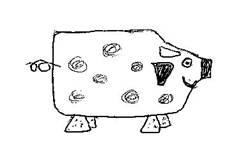 Make a Piggy Bank: Take a gallon milk or juice plastic container. Turn it on its side so the handle is on top. Glue eyes just below the handle on both sides, 4 corks or bottle tops for feet, pink felt ears, and paper circles for spots all over the pig’s body. Twist a pipe-cleaner into a tail and poke it into the plastic behind. Draw on a mouth. Finally, cut a slit in the top for coins. All during Great Lent, we will each collect coins at home (from the sofa cushions, off the floor, by doing chores, etc.) and will bring them in to class to put in the class Piggy Bank to give to the IOCC at Pascha.
Make a Piggy Bank: Take a gallon milk or juice plastic container. Turn it on its side so the handle is on top. Glue eyes just below the handle on both sides, 4 corks or bottle tops for feet, pink felt ears, and paper circles for spots all over the pig’s body. Twist a pipe-cleaner into a tail and poke it into the plastic behind. Draw on a mouth. Finally, cut a slit in the top for coins. All during Great Lent, we will each collect coins at home (from the sofa cushions, off the floor, by doing chores, etc.) and will bring them in to class to put in the class Piggy Bank to give to the IOCC at Pascha.
- Alternate Craft idea: Pig paper bag puppet. Take a paper bag. Use the templates below for either the piggy bank or the bag puppet. Glue the verse to the bottom of the bag. Write the verse on the bottom of the bag: “I shall arise and go unto my Father and shall say unto Him, ‘Father, I have sinned against heaven and before thee, and am no more worthy to be called thy son.’”
- Close with prayer. Ask specifically for each child to be faithful to his “Pigpen Pledge”.

Ears
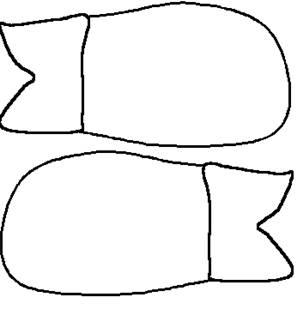
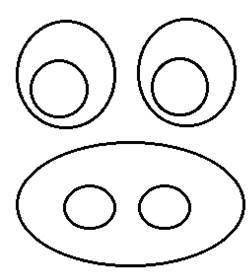 Eyes and nose Arms
Eyes and nose Arms
Last Judgment
THE LAST JUDGMENT
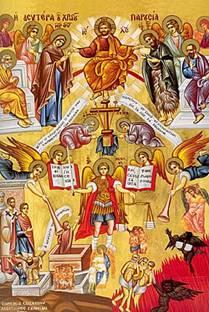 Objectives:
Objectives:
- Children should know that Jesus is coming again as judge.
- Children should be able to list some of the characteristics of goodness.
Possible Lesson Plan:
- Open with prayer.
2. Tell the parable of the Last Judgment: Jesus said, “When the Son of man comes, he will be like a king sitting on a throne. All around the throne will be angels and in front of the throne will be all the peoples of the earth. Then the King will judge the people. He will separate the good people from the bad people. He will have the good people stand on his right side and he will say to them, ‘ Come, O good children of my Father. Receive the beautiful Kingdom that God created for you in the beginning. You have lived as my Father wanted you to live, for when I was hungry, you gave me food to eat, when I was thirsty, you gave me something to drink, when I came as a stranger, you welcomed me, when I was naked, you clothed me, when I was sick, you visited me, when I was in prison, you came to see me.’ Then the people will answer the King: ‘ Lord, when did we see you and do all these things for you?’ And the King will answer, ‘If you were kind or helped anyone who needed help, you helped me. The good things you did to them, you did to me.’ Then the King will say to those at his left side, ‘Because you didn’t help anyone, or weren’t kind or generous to anyone, you didn’t show kindness to me.’ Therefore the King will send them away to be punished forever, but to the good people, he will give life forever in his kingdom.”
- Instead of True/False Questions, have the children try to list the characteristics of goodness, as stated in the parable. Discuss each one: Have we done any of these things? When? Have children tell stories from their own lives.
Add the Sheep and the Goat to your timeline:
- Review some Old Testament stories of judgment: Adam and Eve and the Garden, Noah and the flood, Sodom and Gomorrah and Lot’s wife, Pharaoh and the plagues of Egypt, etc. Each of these can be looked at again in the Read with Me Bible.
5. Play a learning game: Print your Pre-Lenten Path perhaps a bit enlarged on cardstock. If you do it in 4 pages instead of one, it should be nice and big to place on the table. Use markers from any game for the children. Place sheep and goat cards on the blank squares of the gameboard. Children roll dice and move spaces. If they land on a sheep or a goat, they must take it. Winner is the one in the end who has the most sheep, not goats!
6. Make a Last Judgment Booklet: Print the next 4 pages, double-sided, flipping on long edge to make 2 booklets to cut apart for each copy. Review the story and discuss concrete things we can do in each situation: Have the children staple a tiny “bag” of plastic wrap filled with rice or a cheerio on the hungry page, a silk flower or band-aid on the sick page, tape a small paper cup cut in half or a bottle cap on the thirsty page, draw a face behind the bars on the prison page and staple a tiny dress cut of felt or fabric or simply a button on the clothing page. Fold the pages and to make a book
- Close with prayer. Have each child specifically select a Last Judgment good deed to do this week.
- We are about to begin the Lenten Season. Print the Lenten Path and mark off each day at home.
Forgiveness and the Paralytic
FORGIVENESS/ THE PARALYTIC
 Objectives:
Objectives:
- Children should be able to tell the story of the paralytic and his four friends.
- Children should know that Jesus can forgive sins because He is God.
Possible Lesson Plan:
- Open with prayer.
- Read the story of the paralytic in the Beginner’s Bible, pages 328-333, the Children’s Bible Reader, page 187, or the Read with Me Bible, pages 3003-303. Supplement with the Golden Children’s Bible, page 370 or the Arch Book, “The Lame Man Who Walked,” if desired. What does “paralytic” mean? Where was Jesus? Where were the friends with the man? How did they get into the house? What did Jesus do? Say? What happened? How do you think the man felt? His friends?
- True/False Questions:
True False
The paralytic man could not walk. The paralytic man could not see.
There was a big crowd around Jesus. Jesus was all alone in the house.
The man’s friends cut a hole in the roof. The friends went in the window.
Jesus forgave the man’s sins. Jesus told the friends to carry the
Jesus healed the man and he could walk. man back home.
Add the Paralytic to your timeline:
- Talk a bit about disabilities: What would it be like to be a paralytic? Lie on the floor and pretend you can’t move your arms or legs at all. Can you walk? Can you eat? Can you brush your teeth? What would it be like to be blind? Close your eyes or turn out the lights. Pass around several familiar objects – a pencil, a crayon, a brush, a rubber band, etc. Can you identify them? What would it be like to be deaf? Try talking to each other by only moving the lips. Can you understand each other? How do you suppose the paralytic felt when he was healed?
- Who forgives sins? Jesus said something unusual to the paralytic before he healed him. What did He say? The Prodigal Son asked for forgiveness; did the paralytic? We all can forgive each other. Tonight, in church, we’ll be celebrating Forgiveness Sunday. We’ll go from one to another asking forgiveness and being forgiven. Demonstrate and practice with the class how to do the sign of the Cross and a bow and to ask forgiveness. But, only one person can forgive us all our sins. Who is that? When Jesus told the paralytic that his sins were forgiven, Jesus was claiming to be Whom? And, when the paralytic walked, Jesus proved that He was indeed God!
- Make a "movie" of the story by printing on cardstock, color, cut out house and strip, cut slits, and insert strip as the "film" to show the story.
- Close with prayer.
Miracles and Healings
MIRACLES AND HEALINGS
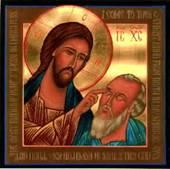
Objectives:
- Children should be able to tell the story of at least one healing of Jesus.
- Children should know the word “miracle” and what it means.
- Children should know the importance of saying, “Thank you”.
Possible Lesson Plan:
- Open with prayer.
- Read the stories of Jesus’s healing miracles in the Beginner’s Bible, pages 340-350,371-374, 405-408, the Children’s Bible Reader, pages 188-189, 213, 221-222, or the Read with Me Bible, pages 308-311 and 350-353. Supplement especially with the Arch Book, “He Remembered to Say Thank You” or with the Golden Children’s Bible pages 369,372,373, 384, and 398. There are many, many healing miracles. Focus on two or three and have the children retell the stories, perhaps with the flannelgraph figures. What kinds of problems did Jesus heal? You may have to tell the children what leprosy is. What kinds of people did Jesus heal? Did He heal the same way each time? We’ll skip the True/False questions today in light of the large number of stories to cover.
Add the Miracles of Jesus to your timeline:
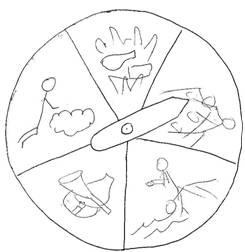 Talk a bit about illness. Ask the children: Have you ever been sick? What’s it like to be sick? Are there different kinds of sickness? Be prepared for them to launch into descriptions of their own pain and suffering. Is it fun being sick? What do we do when we are sick? (Go to the doctor, take medicine, stay in bed, etc.) What did Jesus do when someone came to Him who was sick? (He prayed for them and they got better.) Can we pray to Jesus, too? Can we ask Jesus to help us, too? What do we say to Jesus after asking Him to help us? (Thank you.) The Church has a special sacrament where we pray to Jesus for healing. It is called “Holy Unction.” Have the children repeat the words until they know them. We should call the priest and pray to Jesus whenever we are very sick.
Talk a bit about illness. Ask the children: Have you ever been sick? What’s it like to be sick? Are there different kinds of sickness? Be prepared for them to launch into descriptions of their own pain and suffering. Is it fun being sick? What do we do when we are sick? (Go to the doctor, take medicine, stay in bed, etc.) What did Jesus do when someone came to Him who was sick? (He prayed for them and they got better.) Can we pray to Jesus, too? Can we ask Jesus to help us, too? What do we say to Jesus after asking Him to help us? (Thank you.) The Church has a special sacrament where we pray to Jesus for healing. It is called “Holy Unction.” Have the children repeat the words until they know them. We should call the priest and pray to Jesus whenever we are very sick.
- Make a Story Spinner: Take a paper plate. Divide it into a section for each miracle discussed today, at least 4 and no more than 6. Have students draw a picture of the miracle in the wedge-shaped section of the plate. Use an arrow cut from poster board (or another plate) and a brad to make a spinner. Can the student spin the spinner and tell whichever story it lands on?
Close with prayer, praying especially for anyone known by a student to be sick.
Lazarus
THE RAISING OF LAZARUS
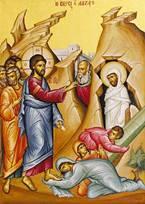 Objectives:
Objectives:
- Children should be able to tell the story of Lazarus in their own words.
- Children should know the names of Mary, Martha, and Lazarus.
Possible Lesson Plan:
- Open with prayer.
- Read the story of the raising of Lazarus in the Beginner’s Bible, pages 418-422, the Children’s Bible Reader, pages 227-229, or the Read with Me Bible, pages 329-339. Supplement, if desired, with the Golden Children’s Bible, pages 423-425. Where was Jesus when Lazarus became sick? Who were the sisters of Lazarus? How was Lazarus by the time Jesus came? What did Jesus do? Why did Jesus cry? What happened to Lazarus after Jesus prayed? Review the story with the icon, identifying Jesus, Lazarus, Peter, and the sister.
- True/False Questions:
True False
Mary liked to sit at Jesus’s feet. Martha sat and listened to Jesus.
Martha was very busy getting things done. Mary was busy getting things done.
Lazarus was very sick and died. Lazarus had a little cold.
Mary and Martha were Lazarus’s sisters. Elizabeth and Anna were Lazarus’s sisters.
Jesus told Lazarus to come out. Jesus told Lazarus to take a bath.
- Play-act the story with one student wrapped like Lazarus in toilet paper. Another student plays Jesus, with students as Mary and Martha and the disciples watching. Jesus prays and shouts, “Lazarus, come forth!” Lazarus enters the room. Jesus tells the others to untie him and the toilet paper is unwrapped.
Add Lazarus to your timeline:
- Discuss death a bit: What is death? Have the children ever known anyone who has died? Why are we sad when someone dies? Mary and Martha knew that Lazarus would rise again someday, but they were still sad. They would miss their brother. Even Jesus cried. Remind the children that Jesus knew that He would also soon die. Is Jesus stronger than even death? (Yes) How did He prove this even before He Himself rose from the dead?
- Need an edible craft? Try "pigs in a blanket" mummy style with thin strips of crescent roll dough wrapped around the hot dog. The craft can bake in the oven as the lesson continues.
- Make the Holy Cross News: Take a newspaper. Have the students cut out words to form the headline they would write if they were reporting on the miraculous event of Lazarus’s resurrection. Glue the words onto a piece of paper and roll into a scroll, tying with a ribbon.
- Begin the Lenten Path Journey. Print the Lenten Path, adapted for Orthodoxy from the Catholic Icing website, on cardstock for each child. Then color or mark off the days already past. Take home and continue to mark each day until Pascha.
- All children love Easter Eggs, right? Begin your set of "Resurrection Eggs" today with an empty egg carton and one plastic. Insert a band-aid or a piece of gauze to represent Lazarus. Or, us the printed "eggs" starting with Lazarus today. Remind the children why we dye eggs red for Pascha -- that the egg of Mary Magdalene turned red right before the eyes of the Roman Emperor!
Close with prayer.
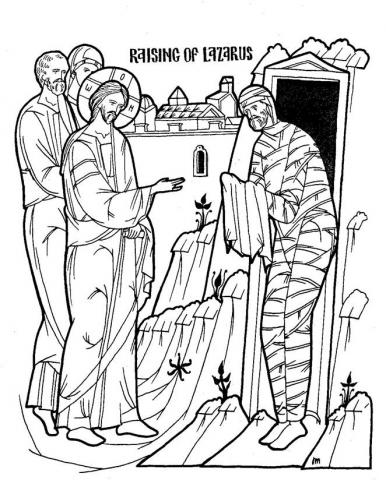
Palm Sunday
PALM SUNDAY
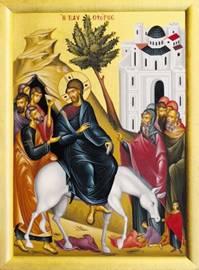
Objectives:
- Children should know that Palm Sunday celebrates Jesus’s triumphal entry into Jerusalem.
- They should be able to identify the characters in the icon and tell the story.
Possible Lesson Plan:
- Open with prayer.
- Read the story of Palm Sunday in the Beginner’s Bible, pages 427-432, the Children’s Bible Reader, pages 230-232, or the Read with Me Bible, pages 358-361. Supplement with the Golden Children’s Bible, pages 428-430, or the Arch book, The Donkey Who Served the King. Use the icon and point out the characters and their roles. How did Jesus get the donkey? What were the people doing? What were they saying? Are there children?
- True or False:
True False
Jesus entered Jerusalem on a donkey. Jesus entered Jerusalem on an elephant.
The people were happy to see Jesus. The people shouted, “Crucify him!”
The people shouted “Hosanna!” The disciples stole the donkey.
The children waved palm branches. Jesus entered Rome on Palm Sunday.
People made a carpet for Jesus with People threw rocks at Jesus.
with their coats.
Add Palm Sunday to your timeline:
- Show pictures of palm trees. If you have them, show the children a palm branch and a pussy willow. Let them hold and touch.
- Add a 2nd egg to your "Resurrection Eggs" with a leaf inside. Review the Lazarus "egg".
- Cut donkey from gray construction paper and color or use yarn for mane and tail. Use clothespins colored gray with black hooves for legs to stand up. Then add green palm branch, cut from cardstock or construction paper, write "Hosanna" on it, and glue or tape to back of donkey. Nice table centerpiece to take home!
Too messy? Try a popsicle stick craft instead. Print the background on cardstock or glue to construction paper and color. Then, cut slit where shown. Print the figure of Jesus from the coloring page or from an icon print, again with cardstock. Cut out the figure and glue or tape popsicle stick on the back. Insert thru the slot and re-enact the triumphal entry into Jerusalem. You can also cut out and glue in some of the people from the icon if desired.\
- Close with prayer.
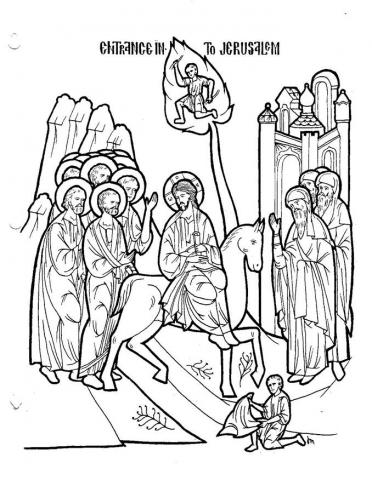
Last Supper
THE LAST SUPPER
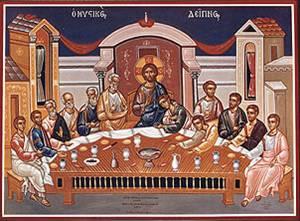 Objectives:
Objectives:
- Children should be able to tell the story of the Last Supper in their own words.
- Children should identify the major figures in the icon.
- Children should know that the Last Supper was also the first Communion.
- Children should be able to name bread and wine as the Communion foods.
Possible Lesson Plan:
- Open with prayer.
- Read the story of the Last Supper in the Beginner’s Bible, pages 437-445, the Children’s Bible Reader, pages 236-242, or the Read with Me Bible, pages 366-381. Supplement with the Golden Children’s Bible, pages 440-447 if desired. What did Jesus wash before supper? Why? What foods did He bless? Who was going to betray Him? Review the story with the icon, identifying the characters, the bread, and the wine. We celebrate the Last Supper on Holy Thursday with the 12 readings of the story.
- True/False Questions:
True False
Jesus washed his disciples’ feet. Jesus washed his hair.
Jesus blessed the bread and wine. Jesus blessed the broccoli.
Judas Iscariot went to betray Jesus. Peter went to betray Jesus.
Jesus prayed in the Garden of Gethsemane. Jesus danced a jig in the garden.
The disciples fell asleep. The disciples prayed with Jesus.
Judas kissed Jesus to betray Him. Judas cut off Jesus’s ear.
Add the Last Supper to your timeline:
- Review the story of Moses and Passover in the Read with Me Bible. Jesus and His disciples were celebrating Passover dinner at the time of the Last Supper. In fact, Jesus is called the Paschal lamb. How is He like the Passover lamb? The lamb saved God’s people from death, just as Jesus was soon to save all people from death. Make an "Egg Carton Last Supper": Print the icon full page size, preferably on cardstock. Leave bottom intact, but cut around the top bodies of all the figures around the table, especially the two on the ends, cutting them down to their hands on the table. Discard the background, leaving figures and table. Cut the top off an egg carton. Then cut the bottom in half lengthwise. Cut off the two end sections, leaving 4 sections. Place upside down. Glue table legs to what is now the front, and table top to the 4 egg cups. Bend the figures up.
- Have a foot-washing: Have the children sit in a circle with shoes off. Take turns washing each others feet. Why did Jesus wash His disciples’ feet?
- Talk a bit about Holy Communion: What do we eat and drink for Holy Communion? Why are these foods special? When was the first Communion?
- Bake Prosphora to use during Holy Week: Tell the students that this is the bread that Father uses for Communion. It would be best to mix the dough at home:
3 cups warm water Mix warm water and yeast
2 tablespoons fast rise yeast first
5 pounds bread flour Add flour, salt, and cool
3 cups cool water water and knead.
1 ½ tablespoons salt
Let the dough rise during Liturgy in the kitchen (not in oven). Divide into a loaf for each child and let the children knead and shape the loaves and stamp them. Take them home again to bake. Help each child to make a list of relatives, living and dead, for Father to pray for.
Too messy? No kitchen? Alternate craft: Egg Carton Last Supper: Print the icon full page size, preferably on cardstock. Leave bottom intact, but cut around the top bodies of all the figures around the table, especially the two on the ends, cutting them down to their hands on the table. Discard the background, leaving figures and table. Cut the top off an egg carton. Then cut the bottom in half lengthwise. Cut off the two end sections, leaving 4 sections. Place upside down. Glue table legs to what is now the front, and table top to the 4 egg cups. Bend the figures up.
8. Add 3 eggs to your "Resurrection Egg" carton -- a silver coin for the betrayal of Judas, a small piece of towel for foot washing, and a grape and piece of bread for the first communion.
- Close with prayer.
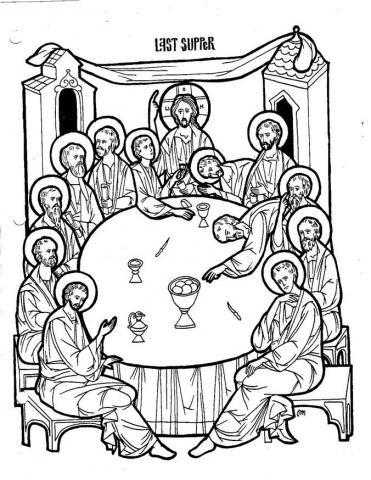
Crucifixion
THE CRUCIFIXION
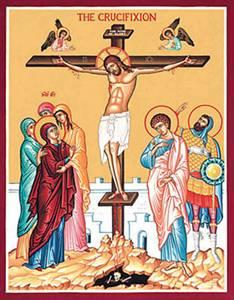 Objectives:
Objectives:
- Children should be able to say the word “crucifixion” and know that it means to be nailed to a cross.
- Children should know the story of Jesus’s crucifixion and be able to tell it.
- Children should be able to identify the characters in the icon and their meaning.
Possible Lesson Plan:
- Open with prayer.
- Read the story of Jesus’s arrest, trial, crucifixion, and burial in the Beginner’s Bible, pages 437-445, the Children’s Bible Reader, pages 242-255, or the Read with Me Bible, pages 382-397. Supplement with the Golden Children’s Bible, pages 448-455, if desired, or the Arch book, “The Man Who Carried the Cross for Jesus”. Where was Jesus when He was arrested? What was He doing? What were the disciples doing? How did Judas betray Him? Peter lied about knowing Jesus how many times? Before when? Who was the high priest? The soldiers put what on Jesus? Who condemned Jesus to death? How did He die? Who carried the cross? Why? What are some of the things Jesus said on the cross before He died? Who was crucified with Jesus? What happened when Jesus died? Who took Jesus’s body to his own tomb? Review the story with the icon, identifying the people. What role did each play?
3. True/False Questions:
True False
Jesus was arrested in the Garden of Gethsemane. Jesus was arrested at home.
Judas betrayed Jesus with a kiss. Judas hit Jesus with a sword.
Peter denied knowing Jesus 3 times. Peter denied Jesus 20 times.
The soldiers put a crown of thorns on Jesus. The soldiers gave Jesus gold.
Pontius Pilate judged Jesus. Moses judged Jesus.
Joseph of Arimathea buried Jesus. Pilate buried Jesus.
Add the Cross to your timeline:
- We celebrate the Crucifixion on Holy Friday. We sing on Thursday about the “Wise Thief”. The story is in the Golden Children’s Bible, page 353, or the Arch book “The Thief Who Was Sorry”. Which thief was wise and why? We also sing on Friday about “The Noble Joseph”. Who was the noble Joseph? What did he do? Play these beautiful songs if you want with tape or CD from the bookstore. Do you remember what we do in Church on Holy Friday? (Procession, candles, the tomb.)
Review by adding several eggs to your "Resurrection Egg" carton, using the ones that you actually stressed in your lessons. There will now be more than 12....either put on top of the egg carton or start a new carton. Some suggestions would be an olive for prayer in the Garden of Gethsemane (full of olive trees), a feather for the rooster of Peter's denial, a small piece of leather for a whip, a small branch from a thorny bush like a rosebush for the crown of thorns, a nail, 3 crosses, a die for the game of the Roman soldiers, a spear, and finally a rock.
- The Cross is the symbol of the Crucifixion. Practice making the sign of the Cross until each child can do it correctly. Role play the prostrations while singing the song “Before Thy Cross”.
- Make a time line, written with readers, in pictures with small fry. Draw on it the events of Holy Week from Lazarus Saturday until Pascha, filling in each detail the children remember and jogging their memories if needed. Or make a card for each event and have the children line them up in order.
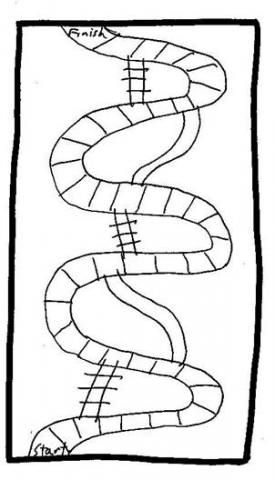
- Make a Holy Week game. Along the lines of chutes and ladders, draw a gameboard. Fill in events of Holy Week along the path, with a penalty (chute) for the bad events (betrayed by Judas, condemned by Pilate, crucified, buried by Joseph of Arimathea, etc.) and a reward (ladder) for the good events (Palm Sunday, washed disciples’ feet, prayed in Garden of Gethsemane, etc.) Have the children choose the most important events from their time line or cards to include on their game board and place them in order. Use dice to play the game; no dice? Tear 6 strips of paper and write a number from 1-6 on each and draw a paper when it’s your turn.
- Or try a Holy Week booklet. Use pictures of icons to color, or the booklet pages after the icons + a description of each day’s events. Decorate a cover and back of construction paper, and bind with ribbon or yarn.
- Time very limited? Color a Holy Week "People Teller" to review all the important people in the drama:Holy Week People Teller
- Cut out the Holy Week People Teller along the outside line
- With the printed side up, fold the square in half horizontally and then vertically, open the folds.
- Turn the square over.
- Fold each corner over so they meet in the middle, do not let them overlap.
- Leave the square folded, and flip the square over.
- Now fold the corners into the center – make sure they do not overlap.
- Fold the entire square in half and poke your thumbs and forefingers in under the flaps.
- Bring your fingers together so the People Teller forms a peak – you are ready to play!
- Can you name all the people according to the clues given?
- Close with prayer.
HOLY WEEK BOOKLET
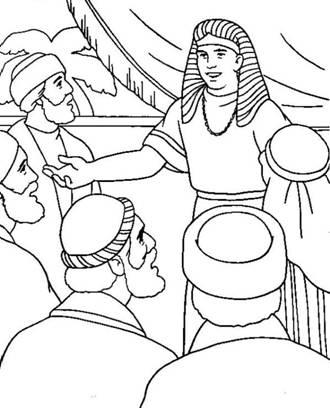
Holy Monday: St. Joseph the Patriarch
A symbol and pre-figuring of Jesus in the Old Testament. You can read St. Joseph’s story at the end of the book of Genesis in the Old Testament. As we think about St. Joseph today, we remember that the great events of the Old Testament become realities in the New.

Holy Tuesday: The Parable of the Ten Virgins
We must make our decision to follow Christ now and not at some point future so that we may watch, pray and be prepared when we are called to join Christ. Our goal should be to seek out the will of God and hold onto his teachings in joyful anticipation of meeting Him.
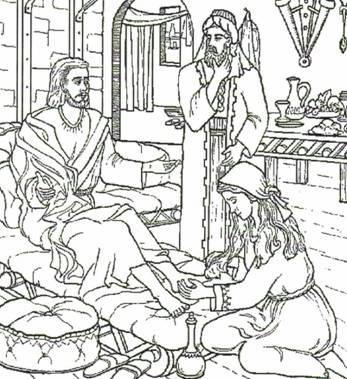
Holy Wednesday: The Betrayal of Christ by Judas and the Sinful Woman
On Holy Wednesday, the Church urges us to think about two people, the sinful woman who poured oil on Jesus’ feet and Judas. The woman came to know Jesus as her savior while Judas chose to betray Him. Judas lost his freedom in Christ, not because he sinned but because he refused to believe that he could be forgiven. The woman, believing that she could be free of sin asked forgiveness and was set free. We must remember that we ourselves deny Jesus when we sin, just like Judas, but we do not have to perish like Judas. We can be like the woman, ask Jesus to forgive us and be set free from our sin.
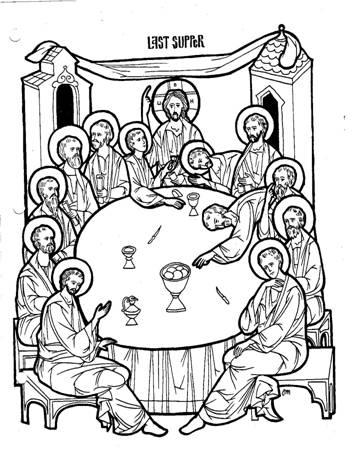
Holy Thursday: The Mystical Supper
At the Mystical Supper, Jesus gave us a new idea of what food and drink means by saying, “Take, eat; this is my Body. Drink of it all of you; for this is my Blood of the New Covenant” (Matthew 26:26-28). These words spoken by our Lord forever identify Jesus with the ordinary human food of bread and wine. We know that our bodies need food in order to live. In the Eucharist, the bread and wine mystically become the body and blood of Christ. God is able to feed us with Himself while at the same time he remains different from us. God lets us share His divine nature in the Eucharist.
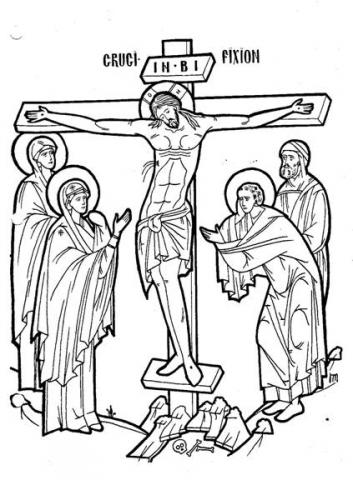
Holy Friday: The Death of Christ on the Cross
On this day, we remember the sufferings of Christ: the nails, the thorns, the spear and death. The day of Christ’s death revealed all the sin that has dirtied our world since its creation. Christ is called, “The New Adam” and in Him there is no sin and no death. Christ chose to trade his life for death and in this way was able to destroy death forever. He chose to suffer greatly in being apart from his Father “My God, my God, why hast Thou forsaken Me!” (Mark 15:34). He then took on the scary experience of dying and said “It is finished” (John 19:30). When Jesus spoke those words, He let everyone know that He was in control of death and that his work to save us was being completed. Death is no longer a final ending to our lives, but a door opening into eternal Life with God, our own Pascha.
Pascha
PASCHA
Objectives:
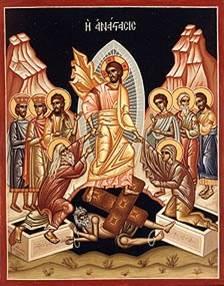 Children should know the Paschal greeting and response, in as many languages as possible.
Children should know the Paschal greeting and response, in as many languages as possible.- Children should know that on Pascha we celebrate Jesus rising from the dead.
- Children should recognize the icon and the figures in it.
Possible Lesson Plan:
- Open with prayer: Teach and sing the hymn, “Christ is risen from the dead, trampling down death by death; and upon those in the tombs bestowing life!”
- Read the story of Palm Sunday in the Beginner’s Bible, pages 453-458, the Children’s Bible Reader, pages 257-258, or the Read with Me Bible, pages 398-399. Supplement with the Golden Children’s Bible, pages 356-358, if desired. Who came to the tomb? Why are we so happy on Pascha? Use the icon to retell the story, pointing out each character. Review the stories of Adam and Eve, of John the Baptist. You can also read one of the Arch books, either “Kiri and the first Easter” or “The Glory Story.”
One more egg for the Resurrection Egg carton -- EMTPY of course!
- True or False?
True False
Jesus rose from the dead on Pascha. Jesus rose from the dead on Palm Sunday.
Judas Iscariot betrayed Jesus. Jesus was crucified on Pascha.
Jesus was crucified on Holy Friday. Caiphas, the high priest, loved Jesus.
Two Marys went to the tomb. Mary and Mary saw a snake in the tomb.
The noble Joseph of Arimathea Peter never denied he knew Jesus.
buried Jesus’s body.
Add the Resurrection to your timeline:
- Teach the Paschal greeting in several languages; the children can respond.
 English: Christ is risen! Indeed He is risen!
English: Christ is risen! Indeed He is risen!
Greek: Christos anesti! Alethos anesti!
Russian: Christos voskrese! Voistinue voskrese!
Arabic: Al-masi-kam! Haq an qaam!
- Make Easter Banners. Take a piece of felt and staple over a coat hanger. Cut out letters to spell “Christ is Risen.” Let the children cut out other decorations – crosses, flowers, eggs, etc. – or bring in silk flowers or lilies. Glue these onto the banner.
- A bit more involved, with the lesson “in the pot” to take home? Make a Resurrection Garden using a pie pan or shallow terra cotta bowl, dirt, quick-growing grass seed, an eggshell on its side or tiny pot for the tomb, one large rock, some small rocks, and 3 crosses made of toothpicks or pipe cleaners. Take home, water daily, and, by Pascha next week, the grass will fill in the lovely scene with new life.
- Close again with the song and a prayer.
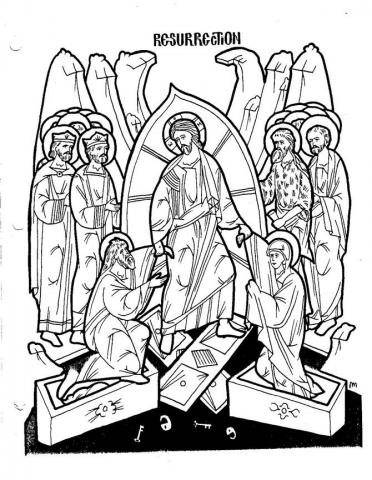
Doubting Thomas
DOUBTING THOMAS
Objectives:
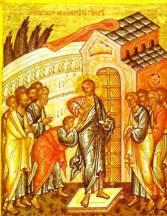 Children should recognize the name of Thomas as a disciple.
Children should recognize the name of Thomas as a disciple.- Children should be able to tell the story of Thomas in their own words.
Possible Lesson Plan:
- Open with prayer.
- Read the story of Thomas in the Children’s Bible Reader, pages 261-263, or the Children’s Bible, page 458, or use the Arch book, “Doubting Thomas”. This story is not in the Read with Me Bible. Who was Thomas? What happened to the other disciples? Was Thomas there? What did Thomas say? What did Jesus do? How did Thomas respond? Why is he known as “Doubting Thomas”?
- True/False Questions:
True False
Thomas was a disciple. Thomas was a thief.
Thomas didn’t believe the other disciples. Thomas saw Jesus before anyone.
Jesus appeared also to Thomas. Thomas never saw Jesus.
Thomas bowed and worshipped Jesus. Thomas ran away from Jesus.
Add Doubting Thomas to your timeline:
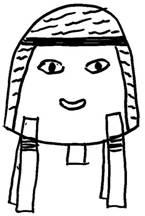 Talk a bit about doubt: Has someone ever told you something that was hard to believe? Listen to the children’s stories of things they would find hard to believe. If someone told you he saw a dead man walking around, would that be hard to believe? Did Thomas believe the other disciples? Would you? Talk a bit about the normal, expected way things usually are: Can the children describe some things that we know should happen in a certain way or look a certain way? Maybe, things fall down, not up; we walk on our feet and not our heads; leaves are green and not purple. Life is full of normal, everyday things and it would be impossible to live life otherwise. Imagine a world where things fell up, down, or sideways at random, where …(go on with your children’s list). But, do things always have to be normal? Is God in charge? Can He change anything He wants when He needs to? So He can and did change death, and surprised poor Thomas.
Talk a bit about doubt: Has someone ever told you something that was hard to believe? Listen to the children’s stories of things they would find hard to believe. If someone told you he saw a dead man walking around, would that be hard to believe? Did Thomas believe the other disciples? Would you? Talk a bit about the normal, expected way things usually are: Can the children describe some things that we know should happen in a certain way or look a certain way? Maybe, things fall down, not up; we walk on our feet and not our heads; leaves are green and not purple. Life is full of normal, everyday things and it would be impossible to live life otherwise. Imagine a world where things fell up, down, or sideways at random, where …(go on with your children’s list). But, do things always have to be normal? Is God in charge? Can He change anything He wants when He needs to? So He can and did change death, and surprised poor Thomas.
- Make Storybook People of Jesus and Thomas. Use a L’eggs egg half or a Styrofoam cup. Clip on clothespins for legs (3 or 4, or it won’t stand up!). Draw on the faces. Draw the clothing, or use fabric. What about yarn for hair? How would Thomas look? Surprised? What about a crown of thorns on Jesus made of pipe-cleaners? Can the children tell the story with dialogue for each of the characters?
Close with prayer.
Myrrh-bearing Women
THE MYRRH-BEARING WOMEN
Objectives:
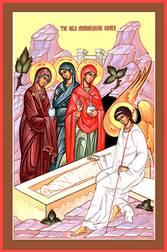 Students should be able to say the word “myrrh” and know its meaning.
Students should be able to say the word “myrrh” and know its meaning.- Students should be able to tell the story of the myrrh-bearing women in their own words.
Possible Lesson Plan:
- Open with prayer.
- Read the story of the myrrh-bearing women in the Beginner’s Bible, pages 456-458, the Children’s Bible Reader, page 257, or the Read with Me Bible, pages 398-399. Supplement with the Golden Children’s Bible, pages 354-356, if desired. There is also an Arch book, “The Easter Women”. Why were women going to the tomb? Why on Sunday? What is myrrh? What did they find? What did they do?
- True/False Questions:
True False
The women went to the tomb on Sunday. The women went on Saturday.
The women carried myrrh. The women carried wine.
They found the tomb empty. They found Jesus’s body.
They told the disciples Jesus was risen. They cried and fell asleep.
Add the Myrrhbearers to your timeline:
 Discuss a bit burial customs. Have any of the children been to a funeral or vigil? What are our customs? See if the children can remember singing “Memory Eternal” or eating koliva. The Jewish custom was to rub the body with myrrh. Why couldn’t the women do it Friday night? (the Sabbath) Where do we go to visit someone who has died? (cemetery) Where was Jesus’s body put after He died? Can you remember whose tomb it was? We usually bury people in the ground and fill the grave with dirt. How was the tomb of Jesus sealed? (stone) How did the women feel when the stone was rolled away? How would you feel if the grave of a loved one were found dug up? But, Jesus’s body wasn’t stolen; He told the women He had risen from the dead! How did they feel now? What did they do?
Discuss a bit burial customs. Have any of the children been to a funeral or vigil? What are our customs? See if the children can remember singing “Memory Eternal” or eating koliva. The Jewish custom was to rub the body with myrrh. Why couldn’t the women do it Friday night? (the Sabbath) Where do we go to visit someone who has died? (cemetery) Where was Jesus’s body put after He died? Can you remember whose tomb it was? We usually bury people in the ground and fill the grave with dirt. How was the tomb of Jesus sealed? (stone) How did the women feel when the stone was rolled away? How would you feel if the grave of a loved one were found dug up? But, Jesus’s body wasn’t stolen; He told the women He had risen from the dead! How did they feel now? What did they do?
- Make a Spicebraid for a Mother’s Day gift. Begin with 6 3-foot lengths of yarn for each child. Fold over in the middle. Tie with a bow at the fold and 1 inch below it. Braid the yarn all the way down and tie with a bow at the bottom. Make several small sachets with a circle of fabric filled with spices and tied with a ribbon. Use the ribbon to tie the sachets along the length of the braid. Hang it at home for all to enjoy.
Close with prayer.
Road to Emmaeus
- THE ROAD TO EMMAEUS
 Objectives:
Objectives:
- Children should be able to tell the story of the road to Emmaeus in their own words.
- Children should know that the disciples recognized Jesus in the breaking of the bread.
Possible Lesson Plan:
- Open with prayer.
- Read the story of the Road to Emmaeus in the Children’s Bible Reader, pages 259-260, or the GoldenChildren’s Bible, pages 356-358. Where were the men going? Why? Who was the stranger? When did they know that He was Jesus? Review the story of the Last Supper, when Jesus last broke bread with His disciples.
- True/False Questions:
True False
The men were going to Emmaeus. The men were going to Nazareth.
They met Jesus on the way. They met John the Baptist.
Jesus told them all about the Bible. Jesus told them “The Three Pigs”.
They knew Jesus when He broke bread. They never knew who Jesus was.
Add the Road to Emmaeus to your timeline:
- This is a good time to review, as Jesus did, the span of the Old Testament and prophets and what they said about the Messiah. When did people first disobey God? Review the story of Adam and Eve. Over and over, God saved His people: Noah and the ark, Abraham and Isaac, Moses and Passover, Jonah and the big fish, the three boys in the fire, Daniel in the lion’s den. Look at the pictures in the Read with Me Bible. In each case, God provided the means of saving His people. What were they? (ark, ram, blood of lamb, fish, Jesus Himself, an angel) He gave His people His law, the Ten Commandments, but they disobeyed even that. Now He has given His Son to save us all!
- Re-enact the scene as the men broke bread with Jesus. Have the students sit in a circle. Have some really tasty bread, with butter and jam ready. Remember to pray before eating. The teacher then can tear off a piece of bread for each student and everyone can eat the bread with butter and jam.
- Decorate a hiking stick, like the ones the men might have used to walk to Emmaeus. The students will have chosen sticks at the camping trip last weekend. Bring acrylic paints for them to decorate them. Using Christian symbols? After they dry, spray with clear spray to fix the paint.
- Close with prayer.
Ascension
ASCENSION
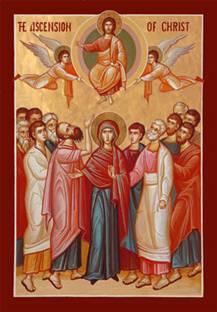 Objectives:
Objectives:
- Children should be able to say “Ascension” and define it.
- Children should identify the characters in the icon and tell the story.
Possible Lesson Plan:
- Open with prayer. Remember especially Pascha and the Paschal hymns and greetings.
- Read the story of the Ascension in the Beginner’s Bible, pages 466-472, the Children’s Bible Reader, page 267, or the Read with Me Bible, pages 402-403. Supplement with the Golden Children’s Bible, page 361, if desired. Use the icon as a visual aid and identify the people as you tell the story. There are Jesus, Mary, angels, and 12 disciples. Can the students name the disciples? Can all the students identify the people and tell the story?
- True/False Questions:
True False
Jesus rose into heaven on Ascension. Jesus died on the cross on Ascension
Mary and the disciples were there. Noah rode him to heaven on an ark.
Jesus told the people that He would Jesus told everyone He hated them.
always be with them.
Jesus is still alive in heaven Jesus is dead and gone.
Jesus told his disciples to wait in Jesus told his disciples to go home
Jerusalem. and go fishing.
Add Ascension to your timeline:
- Was this a sad or a happy story? What did Jesus promise? (That He would always be with us.) Why are Jesus’s hands spread? (He’s blessing us.) What did He tell His followers to do? (To go to Jerusalem and wait for a helper from God.) Where is Jesus now? (in heaven)
- Discuss the butterfly. Use pictures from the library or the encyclopedia. Show the caterpillar, the cocoon, and then the butterfly. Is this the same individual – the caterpillar, the cocoon, and the butterfly? So Jesus was born as a man, died, and rose into heaven – each a different form but the same God.
- Make the Great Commission Plates. Bring in a globe. On one side of a paper plate have the students draw the world, continents and oceans, with blue and tan crayons. Copy the icon and have the students color it. Cut it out in round shape and glue to the other side of the plate. Print with black marker, “Go Ye,” on the side with the world, and the other already says Ascension. Remind the students that Jesus gave us the Great Commission at His Ascension. What is the Great Commission? “Go ye, therefore, and make disciples of all the nations…” Punch a hole in the plate and hang it with a string so it will spin around.
Alternate Craft Idea: Jesus rising into heaven --Make a copy of the icon of the Ascension. Color the disciples and cut out and glue to bottom of light blue construction paper or cardstock. Cut out Jesus, color him, and glue to a white piece of construction paper or cardstock cut like a cloud. Punch hole near center top and at center just above disciples. Take string or yarn to fit around from hole to hole and back and tie; it should be fairly tight. Staple the Jesus-cloud to front of string and move Him up and down from the back with the string. Glue on some clouds of white cotton balls.
Icon figures for craft:
7. Sing the song “Spread the Good News”:
Jump to the left and jump to the right (jump left, jump right)
And sing to the Lord with all of your might! (song directing, strong arms)
Raise your hands and wave them in the air (raise hands, wave around)
And spread the Good News everywhere! (lower hands in a circle)
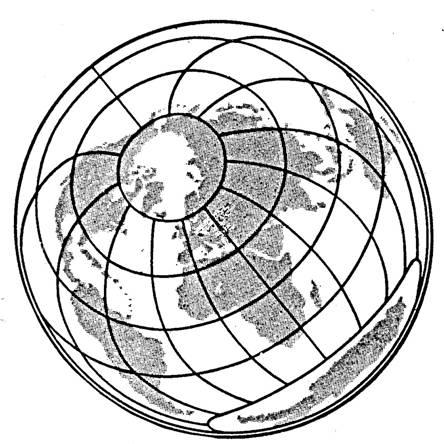
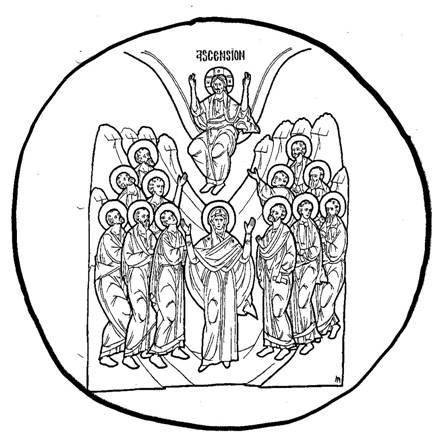
8. Close with prayer.
Pentecost
PENTECOST
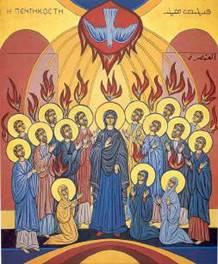 Objectives:
Objectives:
- Children should be able to say the word “Pentecost” and know that this feast is the birthday of the Church.
- Children should know that the Holy Spirit descended on Pentecost.
- Children should be able to identify the characters in the icon and tell the story.
Possible Lesson Plan:
- Open with prayer.
- Read the story of Pentecost in the Beginner’s Bible, pages 473-479, the Children’s Bible Reader, pages 268-269, or the Read with Me Bible, pages 404-407. Use the Golden Children’s Bible, pages 362-363, as a supplement, if desired. Use the icon as a storytelling aid, identifying the characters and their roles. Who’s the little person in the center? (He represents the whole world.) Think a bit about the whole world – all the different peoples and customs. If you have pictures or dolls of people from around the world, show them now. Do they all dress alike? Look alike? But God sent His Spirit to all of us.
- True/False Questions:
True False
The Holy Spirit came down on Pentecost Jesus was born on Pentecost.
Mary and the disciples were in Jerusalem. Pentecost happened in Rome.
Tongues of fire appeared over the heads. Elephants appeared over their heads.
A great wind filled the room. The roof leaked and rain poured in.
The disciples spoke in many languages. The disciples crawled off and hid.
Add Pentecost to your timeline:
- Try just a bit on the Holy Spirit: Can we see the wind? Can we see what it does? Turn on a fan and watch their hair blow, pieces of paper move, etc. Can something invisible be very strong? When is the wind very strong? (tornado, hurricane, etc.) The Holy Spirit is like the wind. We cannot see it, but we can feel it. It is very strong. It is all around us and in us. So when the Holy Spirit came, the disciples could not see it, but they felt it and could hear it blowing and it changed their lives. The day when the Holy Spirit came down is called Pentecost; practice the word. When did each of us receive the Holy Spirit? (Chrismation) Try gluing strips of flame-colored paper to a long strip of paper. Use a blow dryer to blow on the strips. The Holy Spirit came down with a rush of wind and as tongues of fire!
- We’ve now met all the Persons of the Trinity. This is a mystical concept, confusing to even adults. But let’s discuss it briefly. Practice making the sign of the cross and saying “in the name of the Father, of the Son, and of the Holy Spirit.” Who is the Father? Remind the children of the Lord’s Prayer; say it together. Who is the Son? (Jesus) Who is the Holy Spirit? Simple craft? Take 3 craft sticks and glue together in a triangle. Write Father, Son, Holy Spirit on each one. One triangle, 3 sides. Trinity snack? How about 3-flavor Neopolitan ice cream? 1 sundae, 3 flavors.
- The Church was born on Pentecost. Even though Jesus had risen from the dead, the disciples were still frightened and didn’t know what to do. After the coming of the Holy Spirit, the disciples could speak many languages and they were no longer afraid. They went all over the world, telling people about Jesus. What did some of the disciples do after Pentecost? (wrote gospels, traveled to far lands, baptized people, died for Christ) Have a Birthday Party for the Church, complete with cake and candles. How old is the Church?
- Make “Pentecost Placemats”: Give each child a piece of construction paper with a face shape. Have them color the face and draw in hair, eyes, etc. Glue a paper flame above the head. Border of green leaves since green is the liturgical color for Pentecost and we decorate our churches with greenery? Cover with clear contact paper so it will wipe clean.
- Close with prayer. Sing or recite “O Heavenly King”.
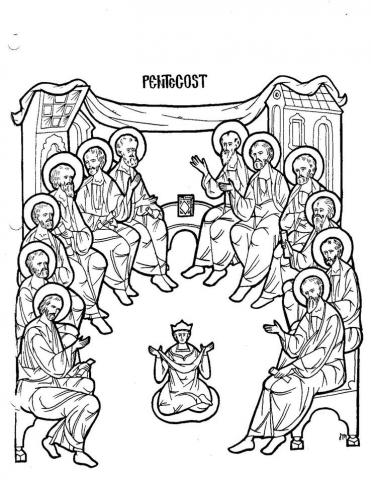
Lord's Prayer
THE LORD’S PRAYER
Objectives:
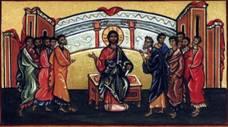 Children should identify the Lord’s Prayer, or “Our Father”, as the prayer that Jesus taught His disciples.
Children should identify the Lord’s Prayer, or “Our Father”, as the prayer that Jesus taught His disciples.- Children should memorize the Lord’s Prayer.
Possible Lesson Plan:
- Open with prayer. Use the Lord’s Prayer.
- Read the Lord’s Prayer in the Beginner’s Bible, page 323, the Children’s Bible Reader, page 194, or the Read with Me Bible, pages 298-299. Supplement with the Golden Children’s Bible, page 380, or the Arch book, if desired. The disciples asked Jesus how to pray the right way. This is the prayer Jesus gave them. Go through the prayer line by line with the children:
“Our Father”: What’s a father like? Who is your father on earth? God is our father, too.
“Who art in Heaven”: Where does God live? What’s heaven like?
“Hallowed be Thy name”: “hallowed” means “holy”; what’s holy mean?
“Thy kingdom come”: What is God’s kingdom?
“Thy will be done on earth as it is in heaven”: Why do things happen to us? Who is in charge?
“Give us this day our daily bread”: Remember the Sermon on the Mount? God even feeds us and takes care of us.
“Forgive us our trespasses”: Do we ever do anything wrong? Do we need forgiveness?
“As we forgive those who trespass against us”: Has anyone ever done anything unkind to you? Have you forgiven that person?
“And lead us not into temptation”: Remember Jesus’s temptations? Is it hard to always obey God?
“But deliver us from evil”: Who is the source of evil? Did Jesus win even over the devil?
- Instead of True/False questions, write each line of the Lord’s Prayer on a card. Read them out loud at random and have the children put them in order. Then say the whole prayer together. Add the children praying to your timeline:
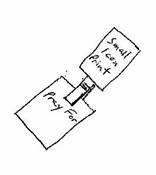 Talk a little about prayer: When and where do we pray? Ask the children how prayer is done in their homes. Do they pray before meals? Do they pray in the morning or the evening? Do they have an icon corner? Do they pray at bedtime? Remind them to say the Lord’s Prayer every morning and evening.
Talk a little about prayer: When and where do we pray? Ask the children how prayer is done in their homes. Do they pray before meals? Do they pray in the morning or the evening? Do they have an icon corner? Do they pray at bedtime? Remind them to say the Lord’s Prayer every morning and evening.- Make a Prayer Reminder: Take a clothespin and apply adhesive magnet strip to one side. Glue a small icon on the other side; we have lots of old bulletins to cut up. Cover it with Contact paper if desired. Take a small pad of Post-It Notes and have the students write on each slip “Pray For”. Take home and stick to refrigerator, beginning with the prayer requests of their friends in class today.
- Alternate craft idea: Make a Lord’s Prayer Puzzle. Use the prayer on the next page and have the students decorate the puzzle and then cut the pieces apart. See if the children can put them back together again!
- Close with the Lord’s Prayer.
